How to make an ePortfolio: a guide for students & teachers
Last Updated on August 25, 2023
A growing number of visual art students now present their work via an online ‘ePortfolio’ or ‘digital sketchbook’. Digital presentation methods have grown in popularity, due to the recent rise in distance/remote learning, and the increase in digital media within classrooms. A 2020 study, which examined how digital technology was used by art teachers, noted that “the emerging theme from the electronic resources code was digital portfolios.” [5] This article outlines the benefits of digital presentation and explain how to create an ePortfolio for students, illustrating some of the best ePortfolio strategies used by high-achieving art students from around the world.
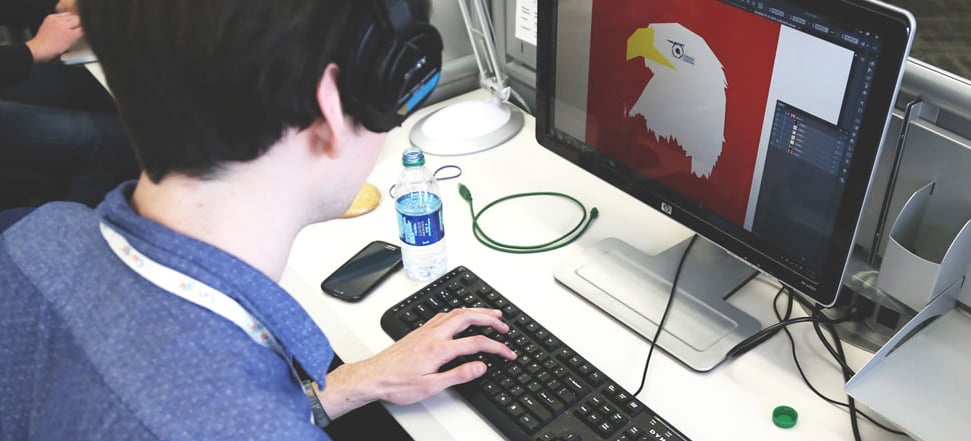

What is in this guide? An index:
What is an eportfolio, why are eportfolios beneficial for art students in particular, things to consider before creating an eportfolio with students, eportfolio layout and organization tips.
- Choosing a platform: requirements for students
Digital tools and platforms: the best online portfolio sites for students
- Bibliography
ePortfolio definition : The word ‘ePortfolio’ is shorthand for ‘electronic portfolio,’ and is sometimes known as an e-portfolio, eFolio, iFolio, web-folio, digital sketchbook, digital portfolio, or online portfolio. It is a place to display creative work online (artwork, photographs, videos, designs, writing, and so on), and may include hyperlinks, headings, navigation menus, and pages combining visual material and text.
ePortfolios in education : Electronic portfolios for students provide a place for students to record their learning, so that material can be accessed remotely by a teacher, classmates and others. Student ePortfolios document learning over time, and provide a place to store, analyze and reflect upon work.
An electronic portfolio (e-portfolio) is a purposeful collection of sample student work, demonstrations, and artifacts that showcase student’s learning progression, achievement, and evidence of what students can do. Center for Teaching & Learning, Berkeley, University of California [1]
In many cases, high school art students use ePortfolios in a similar way that is similar to a traditional art sketchbook with visual imagery displayed alongside typed annotation.
ePortfolio development involves problem solving, decision-making, reflection, organisation, and critical thinking by students developing a learning ‘story’ that accurately represents skills learnt and competencies developed. Dawn Bennett, Diana Blom, Peter Dunbar-Hall, Matthew Robert Hitchcock, Jennifer Rowley, ePortfolios for Creative Arts, Music and Arts Students in Australian Universities (2015) [2]
A well-executed e-portfolio program is an incredible tool for higher education. They provide institutions with authentic assessments of student learning and promote the deeper learning that we want for our students. Candyce Reynolds, Associate Professor, quoted within The Benefits of E-portfolios for Students and Faculty in Their Own Words, Peer Review, Vol. 11, No. 1 (2009) [3]
Although it is well known that artists and designers benefit from displaying their work online (see our guide to creating an artist website for more information about this), ePortfolios offer specific advantages to art students in particular:
ePortfolios can transmit sound and moving image
One of the best attributes of an ePortfolio is that, unlike traditional paper-based presentation methods, they can include audio files, animated images (such as GIFs), and video footage, allowing the communication of ideas via sound and movement. As such, ePortfolios are particularly popular among students who specialize in filmmaking, digital photography, web design, animation, app design, game design, and complex multi-media work. Even those specializing in painting and drawing and other two-dimensional formats are able to show videos of work-in-progress, audio presentations, and so on, communicating in ways that are not possible with traditional methods.
Creating an ePortfolio promotes digital literacy and web design skills
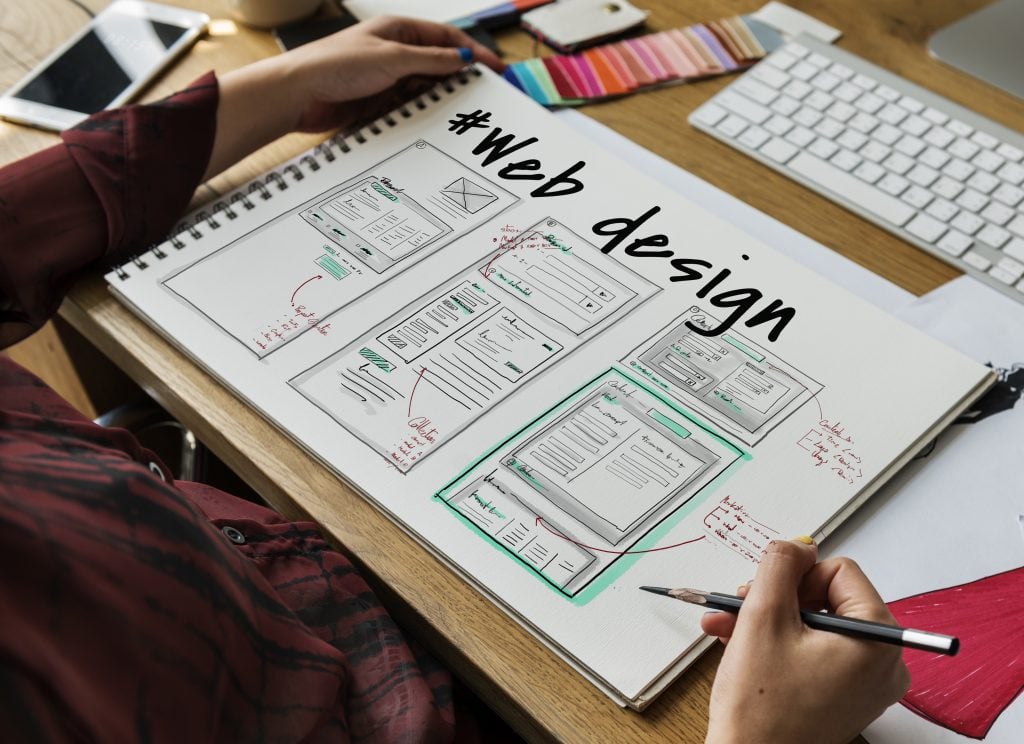
Many students already create logo designs and other graphic design outcomes as part of their high school art programs: website design is a natural extension of this, with options to design the site layout, graphics and font. Many high school qualifications have updated their curriculums to specifically include digital learning. For example, the Cambridge International AS and A Level Digital Media and Design syllabus recently added the following area of study: “Mobile and multimedia applications include web and mobile applications, games, interactive media and digital installation.” This syllabus, as do most high school programs, includes many topics that could form part of an ePortfolio or web design project.
Here is an example of a final website design by a high school student in New Zealand:
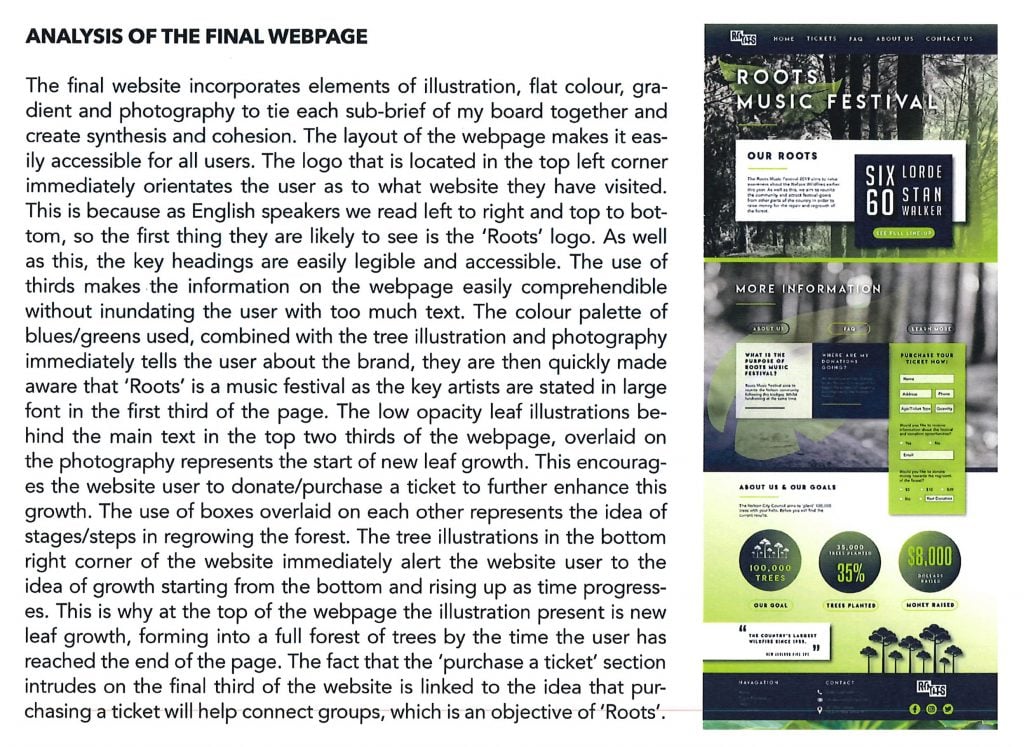
In other words, building an ePortfolio is not simply an alternative way of presenting artwork, but can be an integral way of meeting curriculum requirements, providing “an assessment mode that is more relevant to current and future students in the 21st century.” [4]
Even creating a simple digital portfolio to display student work offers numerous transferrable skills. For example, it encourages the use of scanners, video cameras, and other digital tools, as well as editing software, such as Adobe Photoshop. It also introduces students to web design or blogging software (see below for a detailed discussion on the different ePortfolio platforms that are recommended for students). Having these skills gives students a leg up, regardless of the field they end up entering.
ePortfolios reduce printing and reproduction costs
Graphic design and photography students typically face very high printing costs, with students having to print out material for every assessment. Combined with the cost of a camera and software licenses, this can make such courses prohibitive for many students. Presenting work via an ePortfolio, however, eases this burden dramatically. When work is shared and assessed electronically, printings costs can be reduced significantly, with printing only taking place for final submission or exhibition pieces, for example. This also avoids the rush of 20-30 students queuing for the printer, and is environmentally friendly to boot.
Work can be viewed remotely, without transporting of bulky physical items required
ePortfolios are not only helpful for those studying digital arts, but those specializing in more hands-on disciplines, such as drawing, painting, sewing, fabric design, sculpture and 3D Design. With face-to-face learning currently disrupted in many parts of the world, having a streamlined electronic system for displaying and sharing student work is helpful, particularly when traditional sketchbooks, art supplies, and finished artworks are often bulky and difficult to transport. Even in ordinary circumstances, a mixture of digital and hard-copy submission can help with space, storage and transportation issues in busy classrooms.
We have kids upload photos of their artwork and do essays and critiques, that way so that there is a lot less paper to carry around, a lot less trying to store artwork with that many students since we have such a large department and classroom space is limited. Anonymous high school teacher, quoted by Jesse Strycker, K-12 Art Teacher Technology Use and Preparation, ScienceDirect (2020) [5]
Work can be viewed by many people at any time, fostering constructive critique and in-process feedback
Many ePortfolio platforms have comment functionality built in, allowing students and teachers to offer productive written feedback (comment functionality can be switched off, if moderation becomes a problem). This is particularly successful with students who are less confident about providing verbal feedback in class. Teachers note that many enjoy the low-pressure nature of sharing critique online.
Accessing work via an ePortfolio, without the student needing to be present, also allows teachers to provide individual formative feedback more readily than is always possible in a busy classroom situation.
The process of giving and receiving feedback was rapid and easy, and meant students were able to obtain more individual feedback than had previously been possible, and in a timely fashion, increasing its effectiveness (Gibbs, 2010). Dawn Theresa Nicholson, Enhancing student engagement through online portfolio assessment, Practitioner Research in Higher Education (2018) [4]
Within classrooms, ePortfolios can be projected onto a large screen, or viewed on individual computers, as Sandy De La Rosa describes:
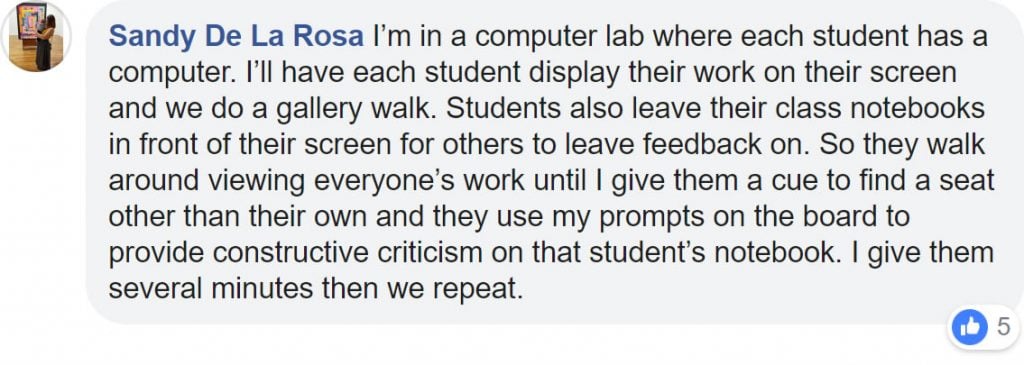
ePortfolios can increase student engagement
An interesting study [4] recently compared two groups of university students, both of whom were asked to complete the same tasks. One group had to submit their work via a paper-based portfolio; the other via an ePortfolio. (This study ran across two years, with over 200 students in total, randomly split into groups). Teachers made the important observation that those who completed an ePortfolio were less likely to leave their work until the last minute . It was suspected that this was because students knew that their teachers would periodically look at their ePortfolio, but never knew exactly when , so they worked more regularly to keep their portfolio updated, just in case the teacher checked it. Teachers also noted that classroom discussions were often more productive, because “students had already read and acted upon feedback.”
Students made progress on their portfolios week by week instead of leaving it all to the end. This was because they knew their sites were going to get displayed the following week…. and also because they knew I was looking at their sites and prodding them if they hadn’t done the work. Anonymous tutor, quoted by Dawn Theresa Nicholson, Enhancing student engagement through online portfolio assessment, Practitioner Research in Higher Education (2018) [4]
In a high school setting, it is not just the teacher who might viewing and comment upon an ePortfolio in real-time, but classmates, parents, and peers. This increased feedback can result in increased levels of engagement. This finding is backed up by another 2018 study which found that ePortfolios promoted an “increase in student engagement and communication with the added benefit of connected learning in the secondary art classroom.” [6]
ePortfolios can double as a career portfolio, improving employment prospects
Many art students earn money from creative pursuits while studying, such as offering photography services, videography, or painting portraits for friends and peers. If an ePortfolio is set up during high school, it can help students marketing their skills and achievements to potential clients and employers. An ePortfolio of this nature could include a resume and artist statement, alongside collections of artwork. (Please note that students should be very careful about uploading contact phone numbers and other identifying details – see our discussion about internet safety below.)
In fact, ePortfolios are considered so valuable for university students, that many institutions now require students to create these as part of their course [7] – in a wide range of disciplines, from education/teaching, music, to science.
…more than four in five employers say an electronic portfolio would be useful to them in ensuring that job applicants have the knowledge and skills they need to succeed in their company or organization. Hart Research Associates, It Takes More than a Major: Employer Priorities for College Learning and Student Success (2013) [8]
Senior high school students who are actively looking to enroll in college or university (see our guide to creating an application portfolio for college or university ) can hence find creating an ePortfolio an excellent way to link learning to real-world goals.
[At] an urban high school in northeastern Georgia, students often complained about their perceived disconnection between classwork and the value of these assignments beyond high school; students made frequent remarks about ELA assignments like, “I’ll never have to do this after high school.” Because of these concerns, the researcher implemented an ePortfolio with a reflection on transferable skills as an intervention to help students reflect on the transferable skills practiced within high school coursework and its value in their future endeavors in college or a career. …[]… Findings from both the quantitative and qualitative data revealed that the ePortfolio with a reflection on transferable skills positively affected high school students’ perceptions of college and career readiness in their high school. Julie Beatrice Kristin, I’ll Never Have to Do This After High School: Exploring Students’ Perceptions of College and Career Readiness and the Effects of Eportfolios With Reflection on Transferable Skills (2020) [9]
ePortfolios can be used as promotional tools within the wider school and community
Parents and school management teams are often impressed at the professional appearance of student ePortfolios. Online material can be projected onto large screens at open days and career nights, providing a ‘virtual window’ into the classroom, offering great marketing opportunities for the Art & Design department. Links to student ePortfolios can be made available from the school or teacher websites for similar reasons. Links to ePortfolios by past students can also showcase outstanding performance in various creative fields.

ePortfolios can streamline the grading process, collating work in a single location
Art teachers sometimes feel like tearing their hair out attempting to assess student work that is scattered across several locations (a finished video clip on YouTube; obscurely labelled files in online folders; hardcopy drawings in a sketchbook; items on a misplaced thumb drive; and over-sized files attached via email). This can become a logistical nightmare when collating and assessing work from hundreds of students.
An online ePortfolio acts as a central hub, collating all work by a single student in one location (YouTube videos can be embedded, image files uploaded, annotation added directly alongside, and even physical artworks can be scanned an added).
Each separate assignment of sub-unit of work can be presented upon a single ePortfolio page, with the teacher scrolling up or down as required to view the entire submission. With this method, each student ‘submits’ only a single link for assessment. Inboxes are not clogged; files do not need to be painstakingly opened one at a time. The teacher opens the appropriate link, and the entire submission is visible – images, multi-media, and text, arranged upon a single portfolio page.
Although critiquing student work from single ePortfolio page is often not as simple as assessing hardcopy work directly in front of you, it is far better than other digital alternatives. It also has the advantage that teachers don’t need to carry armloads of work to-and-from school, and can grade anywhere that they have internet access. This submission technique also allows regular formative feedback to be given via comment features, as described above.
Updating and modifying work is easy
A digital portfolio can be edited, improved and updated as the course progresses, providing a flexible digital document to accompany hardcopy sketchbooks.
Students have been stuffing assignments in notebooks and folders for years, so what’s so new and exciting about portfolios? Portfolios capitalize on students’ natural tendency to save work and become an effective way to get them to take a second look and think about how they could improve future work. As any teacher or student can confirm, this method is a clear departure from the old write, hand in, and forget mentality, where first drafts were considered final products. David Sweet, Student Portfolios: Classroom Uses, Education Research Consumer Guide (1993) [10]
There are several issues to consider before creating an ePortfolio with high school students, particularly if this is to be live on the internet, accessible by the public. (Most ePortfolio platforms have the ability to set these as either public or private.)
Internet safety and privacy: seek parental permission and ensure no contact details are included
Sharing work online involves potential complications with internet safety and privacy. It is vital that students and their families consent to sharing of work via the digital platform and understand what the ePortfolio will involve. Teachers should familiarize themselves with school policies around sharing student work with third parties.
Students should ensure that phone numbers, age, addresses and other identifying details are not included within their ePortfolio. If creating an ePortfolio for marketing purposes, where students want to encourage potential clients, a ‘contact form’ should be used, rather than making an email address publicly visible (automatic bots crawl the internet ‘harvesting’ email addresses, so that they can be sold to others for spam email purposes, so publishing an email addresses online is not advised).
Some schools request that students do not include their full name, and use only an initial for their surname, however, a full name can be helpful for building an online presence, so as long as no contact details are included, this is usually okay.
Ensure content is appropriate for a classroom situation: respectful language, inoffensive imagery
One of the most important things students must understand before posting content to an online ePortfolio is that what goes online, stays online . It is good practice to assume that everything published on the internet (whether to social media, a ‘private’ Facebook group, your own ePortfolio, or otherwise) might be seen by vast numbers of people, and that, once uploaded, you may never be able to remove it or undo it . Numerous automated robots, as well as humans, copy and duplicate digital material, and sometimes the most unexpected content goes viral. Furthermore, the ‘WayBack Machine’ takes permanent snapshots of web pages, archiving the internet, so that web pages can be accessed at a later date even if the material is later taken offline. In short, once material is uploaded to the internet, it is often there permanently, and the original uploader loses control over how it is used or shared. In rare cases, you can quickly delete material before anyone else has seen it, but you should not count on this. Even isolated comments on someone else’s website may come back to haunt, as this man discovered:
…he has commented on someone else’s post and been very offensive towards them. His comments were rude and ill thought out, and were made some six years ago. He has now realised his comments can be found in Google when a search is made for his name – something he didn’t think would happen when he made the comments. Darren Jamieson, What happens online stays online (2016) [11]
Questionable content posted online can compromise students not just in the present, but in the future – in unanticipated ways. For this reason, school administration / management are more likely to become involved if objectionable content is shared with an ePortfolio than had the same material been shared in a hardcopy classroom sketchbook – because the ramifications are much more serious.
It is worth remembering that most students share content online on a regular basis anyway, and will continue to do so, whether they are granted permission to create an ePortfolio as part of a school project or not. Hence, this task provides an excellent opportunity to help students develop responsible strategies for communicating online.
Protect against plagiarism
If work from artists or other individuals is included or quoted within an ePortfolio, this should be formally referenced, as within any other academic project.
There is sometimes the worry that students from one school might plagiarise the work of students from another. Some teachers get around this by having the online portfolio as an end-of-year project that takes place after work after has been formally submitted – or by having the portfolios accessible online, but not discoverable by search engines, so that the ePortfolio cannot be easily found by others (the portfolio can then be made public once the course is complete). It is worth noting, however, that many high school art projects are inspired by multiple practising artists, with ideas developed under the guidance of a teacher in original directions. Hence, mimicking of artwork by single student is hence not usually a major concern.
Verification of ownership: Include screenshots of work in progress and accompany digital submissions with physical artwork
Many qualifications require a school or principal to verify the authenticity of student work before it is submitted for external assessment. This can be more challenging when work is submitted digitally, because it is harder to know whether work has been copied from elsewhere. For this reason, students should document work in progress – showing screenshots at various stages of completion.
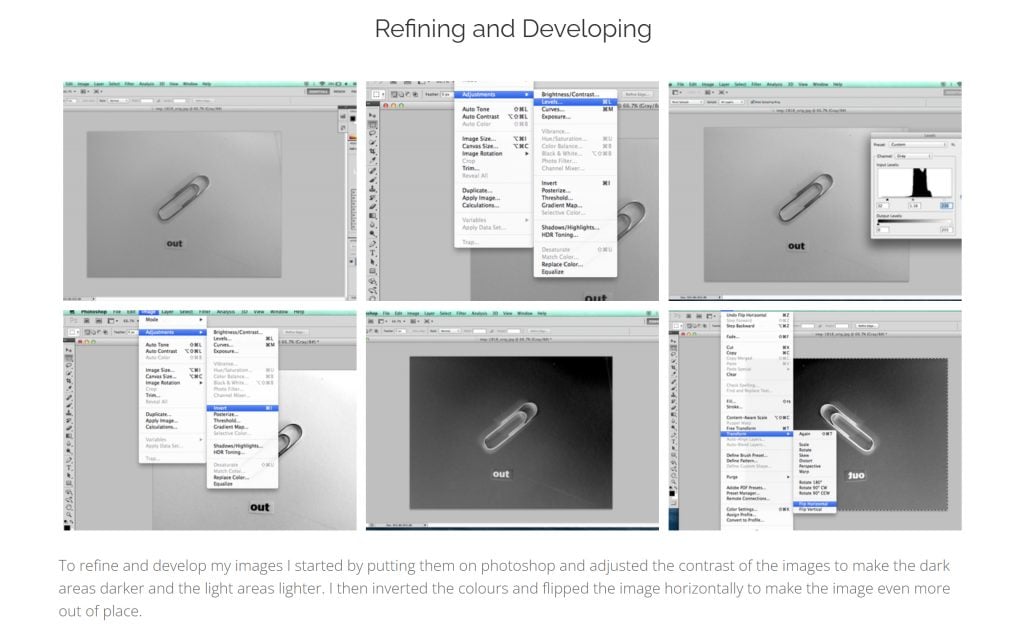
It is also helpful to accompanying digital submissions with hardcopy sketchbooks or artwork, to help to verify ownership of digital work.
Balance screen time with hands-on creation
There are valid concerns about the number of hours young people spend online – something that is only escalating with the lockdowns taking place in many parts of the world. Long hours online and the distraction of social media can affect mood and sleep, compromising productivity and quality of work overall. This is an important consideration when making a choice about what role an ePortfolio will play in the classroom.
There is an immediacy and joy in creating hands-on artwork that is sometimes lacking when interfacing between keyboard and screen. Art students often love the chance to interact with physical media, using their hands to create things – experiencing surface and texture and touch. Creating physical artworks allows the spontaneous transfer of ideas by hand, and strengthens and consolidates practical art-making techniques.
For this reason, students might choose to delay ePortfolio creation until the senior years of high school, leaving the earlier formative years to focus predominantly upon practical art-making skills. Even senior students creating digital art courses benefit from sketching and experimenting with physical media alongside the creation of an digital work (this also helps with verifying ownership of work, as noted above).
Backup the ePortfolio
Digital files used within an ePortfolio should be stored on a memory stick or cloud server (an automatic backup service, such as Dropbox, is recommended). It is also wise to print a copy of each ePortfolio page. These printouts can be bound and submitted so that examiners have a physical copy in case of technological difficulties.
Not all teachers find assessing student ePortfolios straightforward – with some commenting that it sometimes feels like a “wild goose chase” to locate the appropriate item for assessment. [4] The process is much easier if teachers use a consistent class-wide ePortfolio structure and page-labelling, as this enables teachers to navigate directly to the appropriate page in each student’s ePortfolio without hiccup.
In the evaluation, staff expressed strong feelings about the marking process. For some, the process was much improved, while for others, more challenging. The difference appeared to relate largely to the organisation, structure, and formatting of students’ web sites:
How well the students set up the WordPress site, and how they chose to post their portfolio elements, made a significant difference to how easy it was to review work. Dawn Theresa Nicholson, Enhancing student engagement through online portfolio assessment, Practitioner Research in Higher Education, Vol. 11, No. 1 (2018) [4]
There are no fixed rules about how to set up an ePortfolio, however most good ePortfolios use a similar layout and organizational structure. This helps teachers and assessors navigate around the site and view the work without difficulty.
If the purpose and assessment criteria of portfolio are not clear, the portfolio can be just a miscellaneous collection of works that can’t reflect students’ growth or achievement accurately. Adnan Baki, Osman Birgin, The Use of Portfolio to Assess Student’s Performance (2007) [12]
Make a new page for each assignment or unit of work
Students should not haphazardly dump work within the ePortfolio, nor space work out across hundreds of disconnected pages. It is advantageous to publish each assignment or unit of work on its own page, integrating artist research, annotation, reflections, and collections of images and ideas in the one location. This allows the marker to scroll up and down to assess the work, without having to click back and forward between multiple pages. (This is good practice for professional career ePortfolios too, as having more content on a single page makes it easier for Google to understand what each page is about and helps drive traffic to your website – more tips for growing traffic to an artist website will discussed in an upcoming article).
Include a menu, with clearly labelled navigation links

Include a navigation menu at the top of the screen (above or below the main heading) with links to different sections of work within the ePortfolio. A drop-down menu can be used to group pages together in categories and sub-categories. The menu should use clear, easily-understood wording. Teachers often have specific rules and naming protocols for menu items, so that they can locate work without difficulty.
Menu items should be ordered sequentially, to show progression of ideas, and should include a link to the home page, and other key pages (such as an ‘About Me’ and ‘Contact’ page, which are useful for those wishing to use the ePortfolio for career purposes). A second menu can also be included in the footer of the site (at the very bottom of the page).
Ensure content views well upon different screen sizes, with images and text clearly visible
Sometimes as a browser resizes, images and text jump positions, so that what worked well on one screen does not view well on another. Students should resize their browser and view on different devices, to check how the work displays at other screen sizes.
It is hard for examiners to assess work when only part of an image is visible at one time. Remember that examiners are likely to assess student work upon a desktop. If you have tall, narrow artwork, reduce the file size so that the entire artwork is visible on a single horizontal screen. If fine details are not visible at this scale, separate photos can be added showing close-up details.
When annotating artwork, it is helpful if the images are visible on the screen at the same time as the text, so it is clear which images are being discussed.

Use hyperlinks to connect different parts of the portfolio and link to external websites
Hyperlinks play an important role in helping Google’s search algorithm understand online content, and help an ePortfolio be visible in search engines – often an important goal for students wishing to grow their online presence and develop an art career. Hyperlinks also help teachers and assessors navigate their way around your site.
When referencing work from others, it is good etiquette to link to the original source, so that those wishing to seek more information can click through and visit the appropriate website.
Use a simple presentation style
A creative ePortfolio is more than just a place to dump work – the presentation matters. Put thought into color and font selection, aiming for easy readability. When arranging content on pages, remember that overcrowded work or tiny font sizes may make it difficult for examiners to assess work. As with a traditional sketchbook, a clean, minimalist aesthetic is desirable, as this does not distract from the artwork (more ideas about presentation can be found in our guide to creating an outstanding high school sketchbook ).
Introduce the project on the ‘Home’ page
The front page of the ePortfolio is likely to be the first thing that an examiner will see. Use this as an opportunity to summarise the project and outline the purpose of their ePortfolio, adding links to the different key areas of the project.
Add an ‘About Me’ page
An About Me page is particularly important in the case of a career portfolio. Students can add information about themselves here, including the creative services they offer. Students may also include a photograph of themselves (many choose to have the face obscured or hidden for privacy reasons).
Here is part of the text used on an About Me ePortfolio example by a college student seeking to promote her work and gain clients:
Hello and welcome! I’m glad you’re here! My name’s Carter Teal, owner and main photographer of Carter Teal Photography ! I’m currently a college student at The Ohio State University pursuing a field in their Design program. I’m based in Central Ohio and I shoot weddings, couples, portraits, families, and much more! Carter Teal, Carter Teal Photography
Choosing a ePortfolio platform: requirements for students
When selecting where to make an ePortfolio with students, the following should be considered:
The ePortfolio should be portable, so students can use it beyond graduation
Ideally, student ePortfolios should not be tied to school systems, so they are accessible once students have left school – making them helpful for both college and university applications, and beyond. Although material can be manually copied and paste material from in-house platforms for future use, doing this at scale, with multiple students is impractical.
The case was made that PGCE students would be entering the world of work the following year and therefore should have immediate access to their portfolios as continuous professional development tools… Magda Barnard and Sonja Strydom, A tale of two faculties: Exploring student experiences of e-portfolio implementation as a vehicle of reflective learning at Stellenbosch University, The Independent Journal of Teaching and Learning, Vol. 12, No. 2 (2017) [13]
The platform must be reliable, robust, and secure
A stable, well-established digital platform is essential. The longer a platform has been operating, with an active user base, the more likely it is to be secure, without bugs and technical issues. Popular platforms are also accompanied by a huge array of tutorials and training videos to help when students get stuck.
The platform must be simple to use
Young people are often described as ‘digital natives’, however a platform used with high school students must cater towards all skill levels and be sufficiently straight forward and user-friendly.
…despite engaging with so-called ‘millennials’, it was clear that the assumption could not be made that all the students were comfortable with the required technologies and that they knew how to utilise them as expected. …[]…most of the cohort asked for a more hands-on training experience related to multimedia skills (e.g. adding images, videos and sound clips) and granting access to their respective portfolios at the start of the project… Magda Barnard and Sonja Strydom, A tale of two faculties: Exploring student experiences of e-portfolio implementation as a vehicle of reflective learning at Stellenbosch University, The Independent Journal of Teaching and Learning, Vol. 12, No. 2 (2017) [13]
The platform must be flexible and customizable
Art students are keen to add their own mark to their creations. This is particularly critical if students hope to use an ePortfolio for enhancing their career after graduation. The best ePortfolio platforms allow room for self-expression, selecting different layouts, fonts, colors and so on.
The platform should have comment functionality
As noted above, engagement is often driven by comments and responses from teachers and classmates. You may wish to ensure it is possible to switch comments on and off, as desired.
It can be helpful to use the same platform school-wide
If you are creating ePortfolios within the classroom, having all students select the same platform makes teaching and grading more efficient. Teachers can use a common set of resources between year levels (some teachers also create their own website using the same platform, modelling good practice for students and learning how to use the platform together). A school-wide policy means that students all become familiar with the same platform – so changing classes and year levels doesn’t involve relearning how to use another platform all over again.
When students spend more than one year working with digital portfolios, they learn and know the tool. This means students aren’t bogged down with learning the technical stuff. They will become fluent with the technology and be able to concentrate on creation, curation, reflection, connections, and all the things that will really drive their learning. Greg Port, Why ePortfolios, All Saints’ College (2020) [14]
The platform should be inexpensive to use
Free ePortfolio websites for students are popular for obvious reasons, however these come with downsides that must be considered too. Some schools use savings made in printing budgets to cover costs of high-quality ePortfolio platforms. Both free and paid options, with their pros and cons, are discussed below.
There is an almost infinite array of digital tools and software that for making an ePortfolio. Here we discuss their pros and cons, discussing their usefulness within the classroom, and illustrating how some of the best ePortfolio platforms have been used within high school art programmes.

Image-sharing platforms, such as Google Photos, Instagram, Flickr, Padlet, Pinterest, or Artsonia
There are many online platforms where images can be uploaded and organised in folders. These provide a place to store and share images, and are sometimes used by students to generate a simple online portfolio. Teachers and students sometimes create accounts and then follow each other, or contribute to shared folders, groups, or noticeboards. Some of these platforms, such as Google Photos and Flickr , retain technical information about each photograph (such as the camera model, aperture, and so on) which is helpful for photography students.
Padlet and Pinterest allow users to create collaborative online noticeboards or collections, where students and teachers can post images, videos, and links. Padlet has both free and premium versions (a paid teacher license is available), with the free Padlet version limited to only three noticeboards. Padlet has an improved ability to manage harassment and privacy (you can ensure that content is ‘approved’ before it is published, for example), making it suitable for use in classroom situations, particularly with junior students.
Artsonia is a website where student artwork can be uploaded to galleries, and then printed upon various products (such as cups, magnets, T-shirts etc), fundraising for schools in the process. Some teachers use this to create basic online portfolios for students. It sometimes takes a lot of time to set up and manage permissions, however when students upload their own work using their phones this makes the process much easier.
Public image-sharing platforms, like Pinterest and Instagram , expose students to content from a wide range of users, which can be inappropriate or distracting.
There are three main difficulties with these image-sharing platforms, when it comes to ePortfolio creation. Firstly, multiple images and text cannot be easily arranged in sequence upon a single portfolio page, making them unsuitable for many high school programs. Secondly, it is not easy to link or navigate between different sections of the portfolio, or organize content into categories and sub-categories. Thirdly, these platforms do not make it easy to optimize content for search engines, so people are less likely to discover your work while searching in Google. This makes them unsuitable for those students who are looking to create an ePortfolio to promote their career in the future.
School-based platforms such as Canvas or Seesaw
Another alternative is to use your current learning management software for ePortfolio creation. Some students use Canvas to submit digital art and graphic design assignments ( Colorado State University has published a good guide for how to make an ePortfolio on Canvas). Seesaw is another platform that enables students to turn in artwork, with images to be organized in folders and viewable as a public online gallery, with students integrating images, video, text and so on. Other popular school-based platforms include Google Classroom , Edmodo , or Schoology . The disadvantages of these options is that ePortfolios remain tied to the school learning management system, and are not an easily transportable portfolio that is useful for college applications or career promotion going forward. As with the content-sharing platforms above, these approaches are best used with junior students, or those who are less serious about embarking upon a creative career.
Slideshow tools, such as PowerPoint and Google Slides
Slide-sharing platforms allow students to make a digital presentation in the form of a digital slideshow. This involves a combination of scanned drawings and paintings, photographs, digital artwork, embedded videos and ‘voice overs’, assembled alongside reflections, analysis and other typed annotation. Digital slideshows can be presented to class for discussion and critique, or used for college applications. Some high school qualifications, such as IB Visual Art, require students to submit a series of screen-based slides for assessment, using software such as PowerPoint .
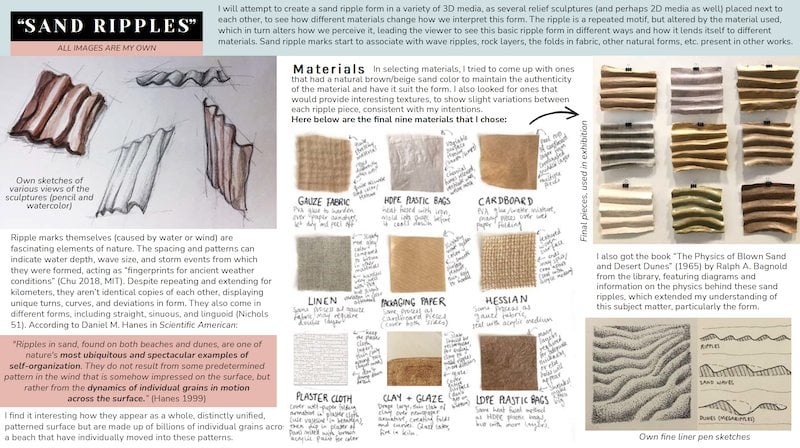
Google Slides is much like PowerPoint, except that students can share links to their presentation or embed these within a blog post, making them more transportable. Students can create presentations using a template created by the teacher, if required. Teachers often find that Google Slides is easy for students to use, with a low learning-curve, although there are complaints about the way Google Slides compresses images, which can leave images blurry.
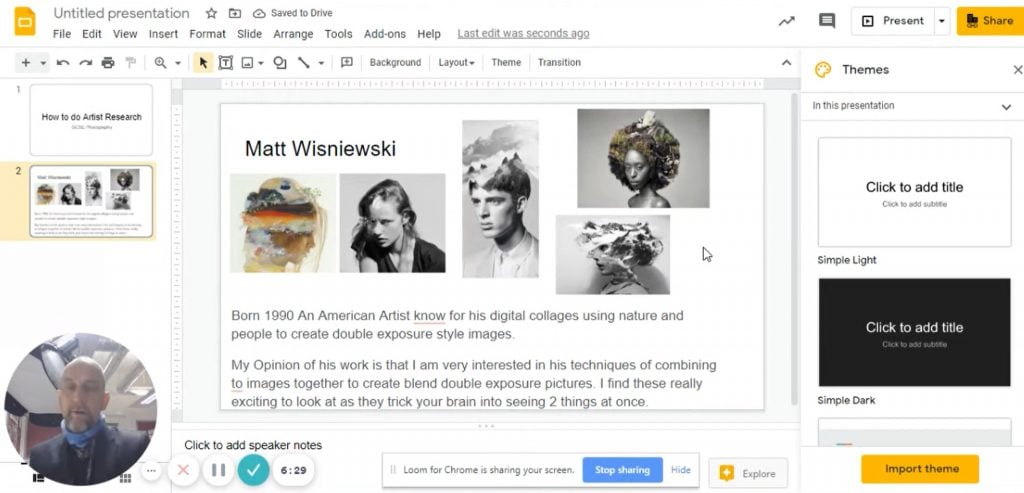
One issue with using slide-sharing tools is that submitting an entire year’s work in a single slideshow makes for a very long, heavy document. Some schools thus ask student to submit a separate slideshow for each unit of work. Although slideshow tools can be used to create complex, high-quality presentations, unlike an ePortfolio website, they cannot be easily used to grow exposure online and are hence not as useful for career purposes.
Professional portfolio platforms such as Adobe Creative Cloud Express or Behance
Another option is to use one of the free platforms used by artists and designers, such as Behance or Adobe Creative Cloud Express (formerly known as Adobe Spark ). These allow you to combine images and text upon website pages (enabling you to scroll down to see all content, rather than clicking through page after page). These are published online, easily shareable with others, and can be retained by the students after they leave school.
Platforms such as Adobe Creative Cloud Express and Behance are typically aesthetically pleasing and easy to use, so students can get up and running with ease. Students often find it motivating to have their work published alongside that of practicing artists and designers (and feel as if they are creating a ‘real’ portfolio) which can encourage high-quality portfolio creation.
Here is an excellent Adobe Spark tutorial by Design and Photography teacher Stacey Churchill, describing how she uses ePortfolios within the classroom):
Note: Do not make the mistake of confusing Adobe Spark with Adobe Portfolio . A number of teachers have had students use Adobe Portfolio, only to discover at the end of the project that it won’t let students publish their portfolio without payment.
There are two problems with these free portfolio platforms. Firstly, they typically have very limited customization options. Many senior high school students find these platforms not flexible enough for their needs. Adobe Spark also doesn’t allow comments and students cannot ‘like’ images, which some teachers find reduces engagement within the classroom. Most importantly, however, ePortfolios created using these platforms cannot be easily optimized for search engines, so it is difficult for others to find the portfolio when searching in Google. This means these platforms have limited usefulness if students hope to use the ePortfolio to grow a client base and promote themselves in the future.
A free web design platform such as Wix, Weebly, Google Sites or Blogger
Creating a stand-alone website is the best option for senior high school students who wish to create an ePortfolio. Many students use a free web design platforms, such as Google Sites, Blogger, Weebly, or Wix. These platforms have drag-and-drop editors, so students can create a website without any HTML or coding required.
Wix or Weebly are the most versatile of these options, and have a professional, aesthetically pleasing appearance, resulting in a site that can be kept following graduation, useful for scholarships and college applications. Both Wix and Weebly have free and premium options.
Here is an excellent Weebly ePortfolio example by a senior high school student:
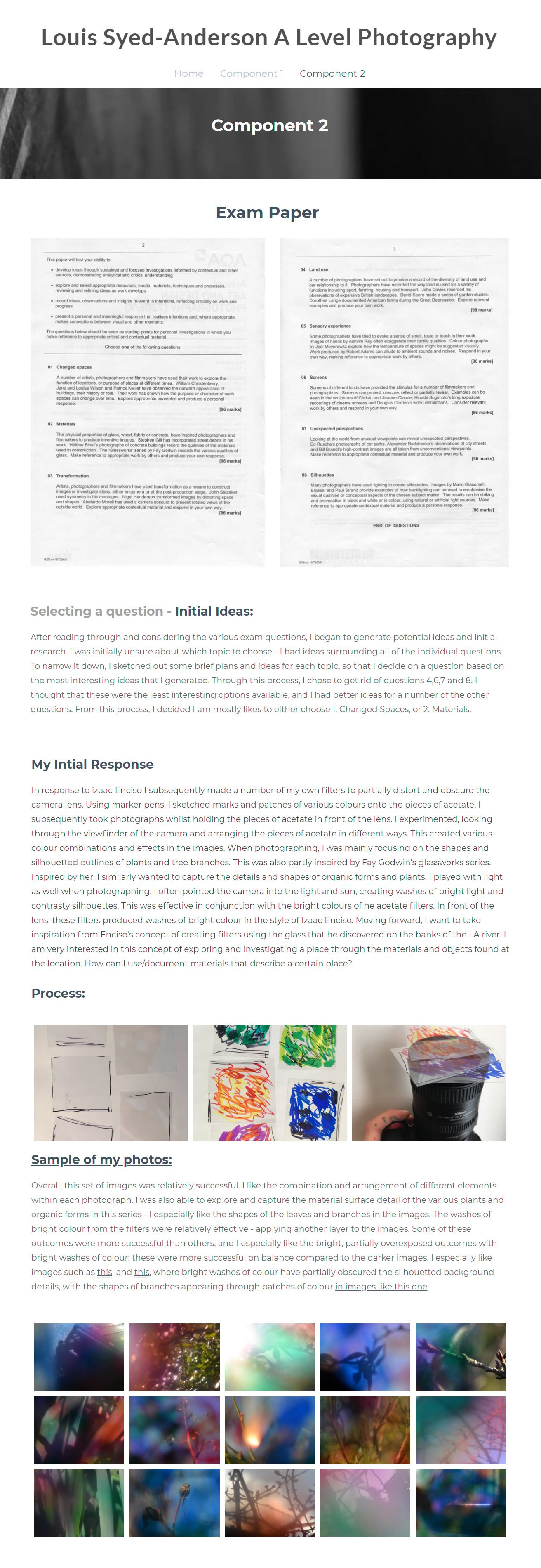
Another option is Google Sites (this is the best Google service for creating an ePortfolio).
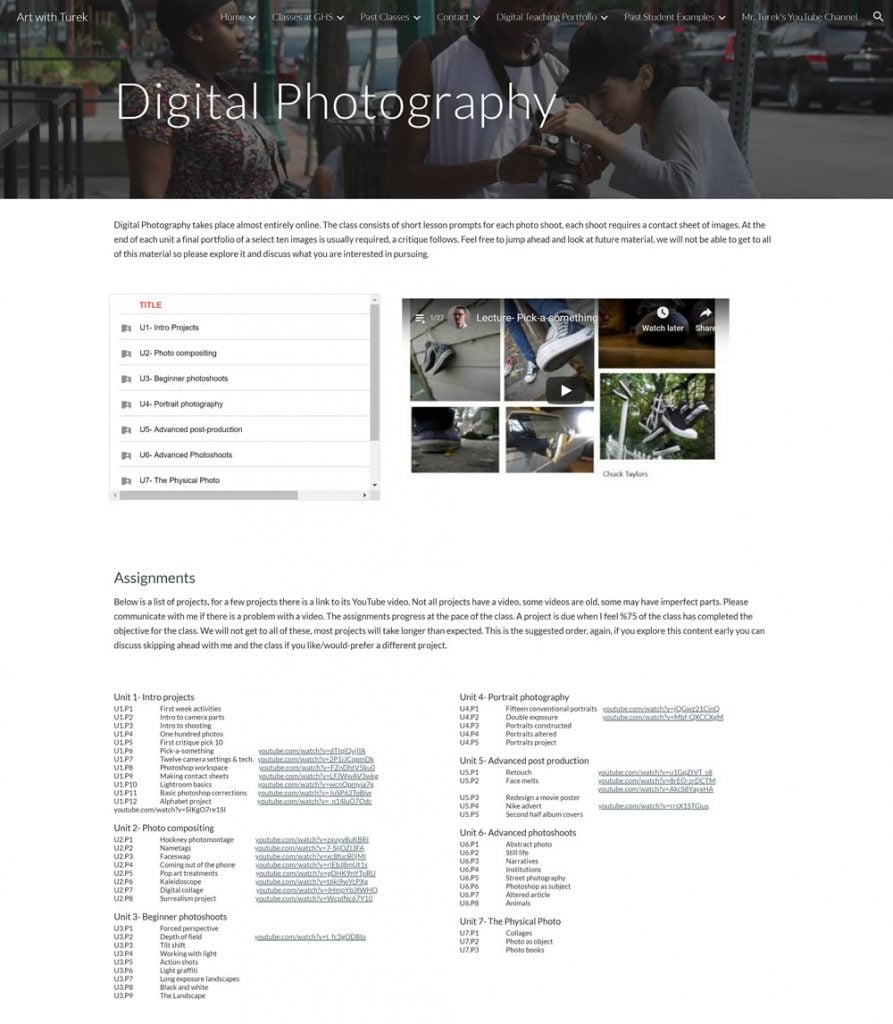
Wondering how to create an ePortfolio using google sites? Here is a great tutorial by Eric Neely, English teacher at The Academies of Bryan Station High School, Kentucky, United States:
Google sites is very easy to use, however some find it challenging to share student portfolio Google Sites with others (one teacher described “constantly dealing with blocking issues when they wanted to send to family members or outside agencies”). If a site is created using a student’s school login, a copy of the site can be shared with their personal Gmail account when the student leaves, so they can retain it once they leave school, however this requires a few steps and may become a hassle when portfolios are created by multiple students. Other schools cannot use Google Sites at all (those designated as ‘Microsoft schools’ for example), because their students don’t use Gmail accounts. Some teachers have also commented that students cannot upload images directly from their phone to Google Sites – work must be saved in Google Drive and then uploaded them to Google Sites, meaning an extra step in the process.
Another Google platform that can be used to create a website is Blogger . This is an older platform, however it is still used by some students and teachers.
A problem encountered by many teachers wanting to create an ePortfolio for students is that a growing number of free platforms are blocked by schools. Sometimes, students or teachers spend considerable effort building up a website or ePortfolio, or are halfway through a project, when the platform is suddenly blocked by their school, as high school photography teacher Wendy Brown McElfish discovered first-hand:

Free ePortfolio platforms are often blocked by schools because these sites attract spammers, who look for cheap and easy ways to set up dodgy websites. To protect students from exposure to these spammy sites, the whole platform itself is often blocked and inaccessible by students.
To complicate things further, many regions are bringing in laws and regulations relating to online education, which means that certain platforms are no longer able to be used with students. For example, teachers in New York State were recently told they were unable to use Weebly anymore, as this is not compliant with the new 2020 NYS data collection privacy law. Other teachers are no longer able to use Wix with their students, due to new age restrictions brought in, with some teachers only permit those older than 18 to publish a site.
Another downside of building an ePortfolio with these tools, is that free platforms are prone to shut down unexpectedly . For example, Weebly recently announced that their education plan (which enabled teachers to manage and view student websites) will soon be discontinued, with all student sites and accounts disabled. Students will not be able to export their websites, requiring students to manually cut and paste all material if they wish to keep their content.
[Weebly] will no longer support student accounts after August 1st, 2022. Students will not be able to log in, and their websites will be unpublished. We’ll delete any student data in your account…
As another example, Wikispaces , which was one of the largest educational wiki sites used by teachers, suddenly disabled all free and classroom wikis in 2018:
As stated in our communication in January 2018 and subsequent site banners; as of July 31st, 2018 all Free and Classroom Wikis were disabled and are no longer accessible.
Free website platforms are particularly vulnerable to collapse, because they do not directly generate revenue for the company. When times are tough, free services are often the first to be cut. Such abrupt changes can have rather dramatic effects upon teaching programs, when hundreds of students might be midway through projects using a particular platform for their course.
Another downside of using one of these platforms is that Google does not like to show free websites in search engines (ePortfolios made using these tools are hence not very useful for driving traffic or growing clients – see more about this in our guide to creating an artist website ) and optimizing content for search engines is difficult. This makes ePortfolios built with Wix, Weebly, and Google Sites far less useful for students who are keen to embark upon a creative career, because it is much harder to drive traffic to these websites.
WordPress (highly recommended)
WordPress is one of the most popular website building tools, and powers almost 38% of all websites on the internet (the Student Art Guide was created using WordPress). It can be used to create any type of website, with written text, illustrated articles, scrolling images, image galleries, embedded video clips, and so on. WordPress is more complicated than Wix and Weebly, but is well within the capabilities of many senior high school students. By comparison, it is easier to use than other digital tools students often use, such as Adobe Photoshop.
Many teachers give students a choice between Wix, Weebly, Google Sites, and WordPress. One high school teacher comments, “Wix seems to be the crowd favorite, with some of my advanced students using WordPress.” Another writes, “Been using Wix for several years. WordPress for the real serious kids.”
Important advantages of WordPress include:
- A WordPress website can be optimized for online search engines, making it easier for others to discover your artwork when they search in Google. (This is why WordPress is the best option for practising artists).
- Students can have their own website name (this is called a ‘domain name’), such as yourname.com . This creates a much more professional impression than yourname.freeservice.com .
- If students decide to sell artwork in the future, they can easily add buy now buttons or shopping carts and sell directly from their WordPress site (this is not possible from the free platforms described above).
- An almost infinite range of features can be added to a WordPress website – contact forms, email sign-up boxes, social media share buttons and so on. All of these are invaluable and are difficult or impossible to implement on most free platforms, enabling students to turn their ePortfolio is a professional website.
In fact, WordPress is considered so useful for students that a growing number of high schools now offer WordPress specific courses. High school teacher Zac Gordon describes teaching students to build websites for clients in the community, and began an internship program, where students started their own companies working on WordPress sites for clients.
There are two versions of WordPress – the basic, free version, which is found at WordPress.com (this has many of the same limitations as the other free platforms described above), and self-hosted WordPress, which is installed at a ‘website host’. A website host is a company that offers space for a website to be stored online so your site is live on the internet. Beginner hosting starts from approximately $2.95 a month (see recommendations for hosting providers at the end of this article ). This price is within the reach of some high school students – particularly when savings in printing are considered. (Some teachers add website hosting to the course fees at the beginning of the year, in replace of a reduced print budget.)
The Student Art Guide will soon be publishing a free WordPress course for high school students, containing all resources and lesson plans needed to teach WordPress within the classroom. This will be an online course that students and teachers can follow along at their own pace. It will teach students how to build a website with WordPress, and will include lesson plans covering the many ways in which web design can be utilized within the curriculum – such as logo design, website layout design, and digital branding etc. We hope to publish this course in 2022. In the meantime, students may wish to read the tutorial we have created for artists explaining how to set up a WordPress website .
NOTE: We are keen to feature more student websites, particularly WordPress ePortfolio examples, within this article. Do you have examples or experience using WordPress within the classroom that you would like to share? Have your students designed websites as part of their high school curriculum? Please make contact via our contact form ! We would love to hear from you!
If you have found this article helpful, please share using the social media buttons at the bottom of this page. Thank you!
BIBLIOGRAPHY
[1] E-Portfolio , Center for Teaching & Learning, Berkeley, University of California
[2] Dawn Bennett, Diana Blom, Peter Dunbar-Hall, Matthew Robert Hitchcock, Jennifer Rowley, ePortfolios for Creative Arts, Music and Arts Students in Australian Universities (2015)
[3] Candyce Reynolds, Associate Professor, quoted within The Benefits of E-portfolios for Students and Faculty in Their Own Words , Peer Review, Vol. 11, No. 1 (2009)
[4] Dawn Theresa Nicholson, Enhancing student engagement through online portfolio assessment, Practitioner Research in Higher Education , Vol. 11, No. 1 (2018)
[5] Jesse Strycker, K-12 Art Teacher Technology Use and Preparation , ScienceDirect (2020)
[6] Megan Johnson and Maia Skarphol, The Effects of Digital Portfolios and Flipgrid on Student Engagement and Communication in a Connected Learning Secondary Visual Arts Classroom (2018)
[7] Planning & Developing Your Public Portfolio , Louisiana State University
[8] Hart Research Associates, It Takes More than a Major: Employer Priorities for College Learning and Student Success (2013)
[9] Julie Beatrice Kristin, I’ll Never Have to Do This After High School: Exploring Students’ Perceptions of College and Career Readiness and the Effects of Eportfolios With Reflection on Transferable Skills (2020)
[10] David Sweet, Student Portfolios: Classroom Uses, Education Research Consumer Guide (1993)
[11] Darren Jamieson, What happens online stays online (2016)
[12] Adnan Baki, Osman Birgin, The Use of Portfolio to Assess Student’s Performance (2007)
[13] Magda Barnard and Sonja Strydom, A tale of two faculties: Exploring student experiences of e-portfolio implementation as a vehicle of reflective learning at Stellenbosch University , The Independent Journal of Teaching and Learning, Vol. 12, No. 2 (2017)
[14] Greg Port, Why ePortfolios , All Saints’ College (2020)
[15] Digital Portfolios: Guidelines for Beginners , Ian Munro, Ministry of Education, New Zealand (2011)

Amiria has been an Art & Design teacher and a Curriculum Co-ordinator for seven years, responsible for the course design and assessment of student work in two high-achieving Auckland schools. She has a Bachelor of Architectural Studies, Bachelor of Architecture (First Class Honours) and a Graduate Diploma of Teaching. Amiria is a CIE Accredited Art & Design Coursework Assessor.
JOIN OVER 21,000 PEOPLE WHO RECEIVE OUR FREE NEWSLETTER
You will be notified first when free resources are available: Art project ideas, teaching handouts, printable lesson plans, tips and advice from experienced teachers. What are you waiting for?
Email Address*
We send emails monthly. And don’t worry, we hate spam too! Unsubscribe at any time.
- Our Mission
11 Essentials for Excellent Digital Portfolios
Guiding your students to get the most out of digital portfolios takes careful planning, and we have ideas to help you get started.

Portfolios have many benefits: They can aid students in metacognition, reflection, and ownership of learning. But if they’re handled poorly, students and teachers may feel that portfolios are a waste of time. And while some see portfolios as excellent qualitative measures instead of standardized tests, we know that the subjective nature of portfolio assessment can make it an unreliable comparison between schools.
You’ll face 11 essential decisions in your pursuit of portfolio excellence.
1. Know Your Purpose
According to Dr. Helen Barrett (PDF), portfolios fall into two categories: the positivist approach (using portfolios for learning), and the constructivist approach (using portfolios as learning).
A portfolio for learning is often a short-term capstone project that will be assessed summatively. At the end of the year, students put selections of their work into a portfolio so a teacher can assess their learning. This is often a showcase portfolio, or a sample of students’ best work.
A portfolio as learning typically has an extended timeframe. This is often formative assessment, but students will also self-reflect and assess themselves. These process portfolios promote student reflection and ownership of the learning process.
On blending elements of positivism and constructivism, Barrett says, “In order to approach a balanced solution, we must envision a solution that makes it easy for students to maintain their own digital archive of work, where they can capture a large number of examples and add their reflections and notes in an ongoing way.”
The answer can be found in using different portions of the portfolio for different purposes, or in having students keep separate portfolios. So be crystal clear about your purpose, as it impacts how you design your portfolio.
2. Select Tools to Empower Students
Adding to the portfolio should be easy. It could be in your learning management system. I prefer my high school students to select the tool for their capstone portfolio. Here are some popular choices:
In their electronic notebook: Perhaps one of the best ways to incorporate a process portfolio is within shared notebooks using OneNote or Evernote . The new OneNote Class Notebook allows teachers and administrators see work in a process portfolio. Students can also keep a page linking to their best work.
Personal website: My older students select from Weebly , Webs , Wix , or Google Sites to build their personal portfolio website.
One-page collection: Sometimes students just want to link to their work published in other places. In this case, a tool like Strikingly , Glogster , or LiveBinders may be used. One of my former students created a one-page wiki for this purpose.
Student blog: My eighth-grade students blog on a private Ning, so their portfolio is a blog post with links to their other blog posts that completed different tasks. Many teachers are using this method on Edmodo , KidBlogs , Edublogs , Ning , or other class blogging tools.
Paper: Some teachers prefer some or all of the portfolio on paper. With private student work such as journal entries, this is often a good idea.
Whatever the tool, select it with your purpose in mind. Share sample portfolios from previous classes. Use templates to help students start. They should focus on selecting the work, so help them on the format.
3. Select a Variety of Content
In addition to print media represented by text and photos, you can use videos, screencasts, hyperlinks to student work, audio recordings, and annotated photographs. If you use only text and photographs, you’re missing the authentic student voice you’d get from audio and video. Students struggling as writers could record a video journal as part of their process portfolio.
4. Empower Portfolio Review and Publish to an Audience
There’s a reason elementary hallways are lined with student artwork—students love an audience. Privacy should always be protected and age-appropriate safeguards should be considered, but we know that an audience for final work improves engagement . As part of revision, portfolio review might include students themselves, teachers, peers, other teachers, parents, or a global audience. Review and feedback should allow a student to grow and change.
When considering publication, online is the obvious choice. But if this isn’t allowed for individual students, teachers can share screenshots on the class blog. Students could also publish part or all of their work in a protected online space for parents to see.
5. Know Your Timeline
You can do portfolios at a certain time of year or over a long period. If you’re doing them throughout the year, make sure students organize themselves to put their portfolio in a place where they can reach it any time they need it. (Students often need to be reminded about putting their work in their portfolio.)
I have my students do their eighth-grade portfolios over a six-week period after they learn the keyboard. My high school students built their personal portfolio website in ninth grade and updated it again in tenth grade. Many of my students use these websites after they graduate from high school.
6. Empower Metacognition
How can your students reflect on their work (or think about their thinking)? Are there ways to ask metacognitive questions ? There are many resources on metacognition because it’s so critically important to learning, and this level of reflection should be incorporated into any portfolio of student work.
For example, a writing portfolio may have students select different pieces that demonstrate how they’ve learned to use voice during the school year. As they write about how they improved in this ability, they’re reflecting on how their thinking evolved. Metacognition lends itself to the process portion of the portfolio.
7. Relate Portfolios to Other Coursework
In Identifying Critical Content , Deana Senn, Amber Rutherford, and Robert Marzano discuss the importance of effectively cueing critical information. One of the concepts they discuss is the advance organization of content, a term coined by psychologist David Ausubel to describe helping students understand the content of a section before it is introduced.
For a science portfolio, you could introduce a unit on water quality by informing students that they’ll be preparing a section of their portfolio where they’ll explain how water quality can be assessed. They can write their opinion beforehand while quoting the data and charts from their learning. In this example, you’ve told students what will be covered so they can begin with the end in mind. So at the beginning of a unit, you can share what type of evidence they’ll be collecting for their portfolio, and you can relate standards to outcomes more clearly using portfolios as advance organizers.
8. Don’t Overwhelm Students
How can you share your rubric and assignment for a long-term portfolio project without overwhelming the student? It can be upsetting to give students the entire portfolio assignment at one time. If you hand out all portfolio requirements at once, assure students that you’ll be guiding them section by section. You can instead give students the portfolio assignments as needed during the year.
9. Link Paper and Electronic Portfolios
How will you relate online and offline portions of the portfolio? Consider linking them with a QR code . This makes it easier to grade the paper portfolio and see the online work without having to type a long hyperlink in your web browser.
10. Consider the Portfolio’s Longevity
How will you help students preserve their portfolios for future use? They often don’t consider their need for the work they’ve done until they’re applying for jobs or want to find it later. With many schools deleting data over the summer, we promote student ownership by letting them take their portfolios with them. When the portfolio is created in an online space, students should save the files and burn them onto a CD or DVD.
11. Engage Teachers in Effective Portfolio Use
How will teachers learn and share best practices so that portfolios are implemented effectively? While perusing the Inter/National Coalition for Electronic Portfolio Research, I came across a finding from Clemson University (PDF) that one of their university’s essential areas for improving portfolio use was “increased faculty support/buy-in.” The Clemson paper notes, “Unfortunately, much of what has been done in the name of programmatic assessment has failed to engage large numbers of faculty in significant ways.”
This emphasizes the importance of involving teachers in successful portfolio implementation.
Speaking From Experience
In my opinion, the best portfolios are part of the learning process. Students reflect on their work and learning. Two important aspects of teaching—metacognition and advance organizing of content—can be done powerfully through portfolios. Students can also have an audience of reviewers and readers. If done well, the final product can further their academic career or get them a job. A well-done portfolio is an essential tool in 21st-century learning. In my classroom, portfolios are essential, powerful means of learning and leveling up.
ePortfolios Explained: Theory and Practice
While ePortfolios might be described as digital collections of artifacts, a good academic ePortfolio also represents a process – specifically, the process of generating new or deeper learning by reflecting on one’s existing learning.
So what is an ePortfolio?
An academic ePortfolio is a digital collection created by a student of their course-related work, like essays, posters, photographs, videos, and artwork; academic ePortfolios can also capture other aspects of a student’s life, such as volunteer experiences, employment history, extracurricular activities, and more. In other words, ePortfolios document and make visible student learning. But a good ePortfolio should be more than just a collection of products.
A good ePortfolio is both a product (a digital collection of artifacts) and a process (of reflecting on those artifacts and what they represent). Like a Learning Management System (LMS), ePortfolios exist online and support student learning. They differ from LMS in two key ways: ownership and control. In a university course, the LMS is “owned” and managed by the instructor who decides who has access, what tools are turned on or off, and so on. With an ePortfolio, the student is in charge: the student decides who can view the ePortfolio, what artifacts get added, how it is designed, and so on. Typically, a student loses access to the LMS when courses end, while ePortfolios remain the student’s property after finishing university.
The learning theory behind ePortfolios
According to Basken (2008), ePortfolios “are a way to generate learning as well as document learning" (Basken, 2008). Generating learning and documenting learning are important, but the process of generating learning sometimes gets overlooked. ePortfolios generate learning because they provide an opportunity and virtual space for students to critically assess their academic work, to reflect on that work, and make connections among different courses, assignments, and other activities, such as work experience, extracurricular pursuits, volunteering opportunities, and more. ePortfolios are effective learning tools because they support students’ own knowledge construction, make otherwise invisible aspects of the learning process visible, and place agency in the hands of students, which fosters learners’ motivation.
Construct knowledge
ePortfolios fall within a learning theory known as social constructivism, which proposes that learning happens most effectively when students construct systems of knowledge for themselves, rather than simply having information presented. Social constructivism also proposes that another determinant of effective learning is that it happens in a social context: we construct our knowledge through dialogue and interactions with others. With ePortfolios, the process of reflection originates as a solo activity, but becomes social through a feedback loop, as the student’s instructor, peers, mentors, and even family members respond to and provide commentary on those reflections. Making and then sharing an ePortfolio with others is somewhat like telling a story: the story of one’s learning journey.
Make learning visible
Bass and Eynon (2009) describe the process of critical reflection involved in the creation of effective ePortfolios as one that makes “invisible learning” visible. By invisible learning, they mean two things.
- Bass and Eynon refer to the intermediate steps that occur whenever a student, or any person, is attempting to learn something or do something. It’s easy to focus exclusively on the final product (such as an essay), and to overlook the stages of learning and doing that preceded that product. By reflecting on these invisible stages, students can learn more deeply, more about how they learn, and how to do better the next time.
- Invisible learning is learning that goes “beyond the cognitive to include the affective, the personal, and issues of identity” (Bass & Eynon, 2009). In other words, the process of learning something doesn’t involve just the rational mind. Rather, feelings, personality, and sense of self are all involved – sometimes facilitating that learning process, and sometimes hindering it. By reflecting on those affective, personal, and self-identity factors, students can develop meta-cognitive skills that can enhance their learning.
Foster student agency
Finally, because ePortfolios are a student-centered activity – one in which the student is free to choose what artifacts are included, and is free to reflect on the process of their learning – they foster engagement and motivation (Tosh, Penny Light, Fleming, & Haywood, 2005). Research shows that when students perceive that they have choices in how to learn they are more engaged and motivated to move beyond simple information acquisition to try to gain an understanding of the subject (Entwistle & Karagiannopoulou 2014; Kuh et al., 2005). ePortfolios offer this opportunity for learner control and can support or promote deep learning as students are able to make connections between the learning that occurs in different contexts. It is this recognition that learning occurs beyond the classroom that makes ePortfolios attractive to many educators.
Types of ePortfolios
Some educators see ePortfolios primarily as a tool for generating new or deeper learning while others view them as a tool for assessment (of students and, by extension, of university programs). Barrett (2008) described the difference in perspective this way: “There’s a major tension right now between student-centered and institution-centered ePortfolios.” Institution-centered ePortfolios, she adds, are driven by “assessment of learning.” Student-centered ePortfolios, on the other hand, are driven by “assessment for learning,” which refers to academic assignments that fulfill the traditional role of assessing student learning while at the same time providing an opportunity for students to learn as they complete the assessment.
Even within the student-centered approach to ePortfolios, it’s possible to classify different kinds of ePortfolios based upon the purpose of the ePortfolio for the student. Different organizations use different names with some distinctions between what the institution or research group wants to emphasize. LaGuardia Community College’s ePortfolio initiative shares these three types of ePortfolios:
- Assessment ePortfolios: the audience is internal to the institution and the goal is to support institutional outcomes assessment.
- Learning ePortfolios: the audience is students themselves, and the goal is helping students examine and reflect on their learning.
- Career/Transfer ePortfolios: the audience is external, and the goal is to provide students with a tool for showcasing their achievements to employers or transfer institutions.
Best practices for instructors
When ePortfolios have broader institutional uptake, students will be encouraged in all of their courses to use their ePortfolio, and to reflect on and make connections between all of their courses and academic experiences. For this reason, ePortfolios are most effective when they are established as an institution- or program-wide initiative, but they can still be successful at the individual course level. To ensure this success, it’s important to observe a number of best practices.
Explain the benefits of ePortfolios to students
ePortfolios can help learners develop new or deeper learning, which results in higher grades, and a better sense of themselves as students and as individuals. ePortfolios can also be shared with friends and family members and showcase learners’ achievements when they are applying for a job.
Establish clear expectations
Explain to your students what you expect them to do in their ePortfolios. Learners may have difficulty understanding the need for them to reflect on their work and the need for them to make connections between different courses and experiences.
Provide numerous examples of successful ePortfolios created by students
Direct students to examples of effective ePortfolios created by Waterloo students , such as this ePortfolio by Knowledge Integration student Danielle Cruz that features “course skills spotlights” and more.
Scaffold student learning
Help students start small. Ask them to choose just one artifact (such as an essay) and have them reflect on the challenges they had to address as they wrote their essay. Or, have the students select two assignments from different courses, and have them reflect on how each of those assignments helped them to better understand the other assignment.
Walk the talk: share your own ePortfolio
Create an ePortfolio for yourself and share it with your students. You’ll better understand the challenges and benefits of maintaining an ePortfolio, and it will also persuade students that it is a useful endeavour.
Tie ePortfolios to assessment
Maintaining an ePortfolio demands a significant amount of time and energy from students, and they will resent it if their time and energy are not reflected in their final grade. If ePortfolios are merely an optional assignment that is encouraged but not required, most students will not undertake one.
Make it social
Integrate viewing and commenting on other students’ ePortfolios as part of the assessment. You could, for example, have a link to each student’s blog in in your university’s LMS. Additionally, you could create a discussion using your LMS where students make helpful and encouraging comments on one another’s ePortfolios. The ePortfolios, then, become an integral part of the online community of students. Adam Rothman, of Georgetown University, refers to this approach as the hub-and-spoke model.
Assessment of ePortfolios
Because ePortfolios require a significant investment of time and energy from students, it is important that they be assessed carefully, and that the assessment contributes in a substantial way to a student’s final grade in a course. However, there are challenges to assessing ePortfolios. For example, how does one evaluate the quality of a student’s reflections? Furthermore, if students come to see their ePortfolios as “just another assignment,” then they will not engage with it in an authentic way and it may become just another “hoop” for them to jump through. Helen Barret (2005) suggests that “high stakes assessment and accountability are killing ePortfolios as a reflective tool to support deep learning.” A balance needs to be found: one that strives to help students appreciate the genuine benefits that they will experience by developing an ePortfolio that captures their work and personal reflections, but which also acknowledges that assessing ePortfolios is not a merely “subjective” and can be assessed by objective standards.
Perhaps the best way to overcome these assessment challenges, while still ensuring that students benefit from their ePortfolios, is to assess ePortfolios with a rubric (such as this rubric developed by the University of Wisconsin ). Furthermore, consistent formative feedback, either left by the instructor or by other students, helps learners maintain motivation to work on their ePortfolio, while also providing feedback to assist in subsequent reflections or other additions to their work. With formative feedback, there is no need to provide a grade for the work they have contributed – scaffolded feedback to guide them in their learning journey can be very beneficial.
If you would like support applying these tips to your own teaching, CTE staff members are here to help. View the CTE Support page to find the most relevant staff member to contact.
- Barrett, H. (2008). Balancing “eportfolio as test” with “eportfolio as story.” Presented at Making Connections conference.
- Basken, P. (2008, April). Electronic portfolios may answer calls for more accountability . The Chronicle of Higher Education.
- Bass, R. & Eynon, B. (2009). Capturing the visible evidence of invisible learning . The Academic Commons .
- Entwistle, N. & Karagiannopoulou, E. (2014). Advances and innovations in university assessment and feedback. Kreber, C., Anderson, C., Entwistle, N. & McArthur, J. (eds.). Edinburgh University Press, pp. 75-98.
- Kuh, G. D., Kinzie, J., Schuh, J. H., & Whitt, E. J. (2005). Assessing conditions to enhance educational effectiveness . San Francisco: Jossey-Bass.
- Tosh, D., Penny Light, T., Fleming, K., & Haywood, J. (2005). Engagement with electronic portfolios: Challenges from the student perspective. Canadian Journal of Learning and Technology, 31 (3).
CTE resources
- Examples of student ePortfolios
- Integrative Learning resources
CTE teaching tips
- Critical Reflection
- Teaching Metacognitive Skills
University resources
- EdTech Hub: PebblePad
Other resources
- LaGuardia Community College’s ePortfolio initiative
- Cambridge, D., B. Cambridge and K. Yancey (2009). Electronic Portfolios 2.0: Emergent Research on Implementation and Impact . Sterling, VA: Stylus.
- Cambridge, D. (2010). ePortfolios for Lifelong Learning and Assessment . San Francisco, CA: Jossey-Bass.
- Chen, H.L. & Penny Light, T. (2010). Electronic Portfolios and Student Success: Effectiveness, Efficiency, and Learning . Washington: Association of American Colleges and Universities.
- Eynon, B. (2009, January). “It helped me see a new me:” ePortfolio, learning, and change at LaGuardia Community College. Academic Commons .
- Peet, M., Lonn, S., Gurin, P., Boyer, K. P., Matney, M., Marra, T., Simone Himbeault, T., & Daley, A. (2011). Fostering integrative knowledge through eportfolios. International Journal of ePortfolio, 1 (1), 11-31.
- Penny Light, T., Chen, H.L., & Ittelson, J.C. (2011). Documenting Learning with ePortfolios: A Guide for College Instructors. Jossey-Bass.
Catalog search
Teaching tip categories.
- Assessment and feedback
- Blended Learning and Educational Technologies
- Career Development
- Course Design
- Course Implementation
- Inclusive Teaching and Learning
- Learning activities
- Support for Student Learning
- Support for TAs
- Blended Learning and Educational Technologies ,
- Course Design ,
- Teaching centers

ePortfolios: The What, Why, and How!

What is an ePortfolio?
An ePortfolio is a collection of work (evidence) in an electronic format that showcases learning over time. Creating a digital portfolio encourages students to take responsibility for their learning and showcase that learning with others. An ePortfolio lets students organize, document, and display their most significant learning experiences in one digital space. The reflective learning process of creating and building a portfolio over time deepens their learning AND yields a dynamic product that makes learning visible to any audience.
Some educators see ePortfolios primarily as a tool for generating new or deeper learning while others view them as an assessment tool. Educator Helen Barrett described the difference in perspective this way: “There’s a major tension right now between student-centered and institution-centered ePortfolios” (Barrett, 2008). Institution-centered ePortfolios, she says, are driven by “assessment of learning.” In contrast, student-centered ePortfolios are driven by “assessment for learning,” referring to the academic assignments that fulfill the traditional role of assessing learning while providing an opportunity for learning to occur during completion.
Even within the student-centered approach to ePortfolios, it’s possible to classify different kinds of ePortfolios based on the student’s purpose. LaGuardia Community College’s ePortfolio initiative , for example, distinguishes between three types of ePortfolios. There’s the assessment version, where the audience is internal to the institution and the goal is to support institutional outcomes assessment. In learning ePortfolios, the audience is the students themselves and the goal is to help them examine and reflect on their learning. And finally there are Career/Transfer ePortfolios, where the audience is external and the goal is to provide students with a tool for showcasing their achievements to employers or transfer institutions.
Best practices for instructors
Explain the benefits of eportfolios to students.
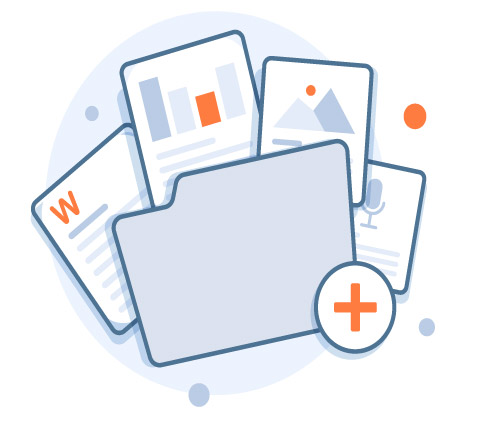
- Help learners develop new or deeper learning, which results in higher grades
- Help learners develop a better sense of themselves as students and individuals
- Be shared with friends and family members
- Showcase learners’ achievements
Establish clear expectations
Explain to your students what you expect them to do in their ePortfolios. At first, learners may have difficulty understanding the need for them to reflect on their work and the need for them to make connections between different courses and experiences.
Provide examples created by students
As you build your own directory of student examples, direct students to LaGuardia’s ePortfolio gallery for inspiration and clarity on scope and purpose.
Scaffold student learning
Help students start small: ask them to choose just one artifact (such as an essay) and have them reflect on the challenges they had to address while writing. Or, have the student select a pair of assignments and have them reflect on how each helped them grow in the field.
Walk the talk
Create an ePortfolio for yourself based on your teaching practice or research project and share it with your students. You’ll better understand the challenges and benefits of maintaining an ePortfolio, and it will also convince students that it is a useful endeavor. Here are some examples to help get you started!
Make it social
Integrate viewing and commenting on other students’ ePortfolios as part of the assessment. For example, have a Canvas page with links to each student’s ePortfolio, or a discussion forum or VoiceThread where students can conduct a virtual gallery walk and make helpful and encouraging comments on one another’s ePortfolios.The ePortfolios then become an integral part of the online learning community. Professor Adam Rothman of Georgetown University refers to this approach as the hub-and-spoke model .
Assessment of ePortfolios
Since ePortfolios require a significant investment of time and energy from students, it is important that they be assessed carefully. However, their assessment does present some challenges: how does one evaluate the quality of “reflections”? If students see their ePortfolio as “just another assignment,” then they may not engage with it authentically. Helen Barrett suggests that “high stakes assessment and accountability are killing ePortfolios as a reflective tool to support deep learning”: (Barrett, 2005). Rubrics (such as this rubric developed by the University of Wisconsin ) may be the best way to overcome assessment challenges while still ensuring students benefit from their ePortfolio. Lastly, consistent formative feedback from the instructor, faculty, and student peers helps learners maintain motivation to work on their ePortfolio.
Canvas Student Pathways
Portfolium (Canvas Student Pathways, CSP) has been recently acquired by UM System and is fully integrated with Canvas. CSP is an online portfolio system allowing users to archive examples of their academic work and experiences in college. Work samples including papers, presentations, projects, audio and video files, designs, essays, and photo galleries all make great contributions to a portfolio. At its core, CSP is a cross between social media and an archive (think Linkedin, but a deeper look at the person rather than the person’s professional connections) so that students can make their identity, knowledge, and skills visible to any audience they choose, including employers, graduate schools, peers, and college faculty and staff.
Barrett, H. (2008). Balancing “eportfolio as test” with “eportfolio as story.” Presented at Making Connections conference.
Basken, P. (2008, April). Electronic portfolios may answer calls for more accountability . The Chronicle of Higher Education.
Bass, R. & Eynon, B. (2009). Capturing the visible evidence of invisible learning The Academic Commons.
CanvasLMS (2020). Portfolium: Digital Citizenship & Personal Branding with Folios [Video] YouTube. https://youtu.be/O_sEwq6ZoK0

Bryant Lazenby, M.Ed.
Laz is a lifelong learner and technology lover who joined Missouri Online as an instructional designer in July 2021. He is a Level 2 Google Certified Educator with over 10 years of teaching experience in secondary and post-secondary education and is currently working on a doctoral degree in educational leadership from Lindenwood University where his research is in incorporating gamification strategies into the classroom. He was born and raised on a farm that has been in his family for over a century located northwest of Sedalia, Missouri, where he lives today. When he isn’t in front of his computer, he can generally be found reading or attending local painting classes.
Share this article

- Teaching Tips / Technology
Best Practices of Using ePortfolios for Students’ Learning
by rhu30 · May 19, 2021

In our last blog post , we discussed the benefits of using ePortfolio to support student learning. When building their ePortfolios, students would collect multiple projects and artifacts and then make connections among them. ePortfolios work the best when they are implemented program-wide or institution-wide. But they can still be at a smaller scope, such as for capstone projects, multi-semester classes, cross-discipline classes. Below are some best practices to implement ePortfolios.
Explain the benefits of ePortfolios to students

Establish clear expectations

Select the right ePortfolio platform

Review the ePortfolio platform and existing ePortfolio examples with your students

Build your own ePortfolio

Tie ePortfolios to assessment

ePortfolio rubric developed by the University of Wisconsin
Make it social

In the next blog post about ePortfolios, we will discuss a few tools and platforms for Georgia Tech students to build ePortfolios. If you are an instructor and have successfully used ePortfolio for your project, we would love to hear from you. Send an email to [email protected] , and we might be able to feature your innovative usage in a future post.
Acknowledgment:
You may also like...

Active Learning in Flexible Courses
June 24, 2020

Unlocking Academic Excellence: Using Generative AI to Create Custom Rubrics
May 1, 2024

Accessibility Always Matters
September 2, 2020
- Next story Tools for Georgia Tech Students to Create ePortfolios
- Previous story Supporting Students’ Learning with ePortfolios
| S | M | T | W | T | F | S |
|---|---|---|---|---|---|---|
| 1 | ||||||
| 2 | 3 | 4 | 5 | 6 | 7 | 8 |
| 9 | 10 | 11 | 12 | 14 | 15 | |
| 16 | 17 | 18 | 20 | 22 | ||
| 23 | 24 | 25 | 26 | 27 | 28 | 29 |
| 30 | 31 | |||||
- Awards (13)
- Campus Voices (48)
- Commentary (19)
- Events (32)
- Fellows Programs (7)
- Future Faculty (20)
- Monthly Blog Theme (3)
- Podcast (4)
- Quick Teaching Tips (10)
- Remote Teaching Videos (7)
- Resources (29)
- Student Voices (11)
- Sustainability (5)
- Teaching Tips (78)
- Technology (38)
- Transformative Teaching and Learning (2)
- Uncategorized (5)
Quick links
- Make a Gift
- Directories
ePortfolios
What are canvas eportfolios.
The Canvas ePortfolio tool allows you to electronically collect and reflect upon various “artifacts.” Artifacts may include essays, photos from study abroad experiences, scans of papers with teacher comments, PowerPoint presentations, Web sites, digital video projects, audio recordings—basically anything you've created as part of your university learning experience.The Canvas E-Portfolio tool provides interfaces for easy uploading of artifacts and password-protected Web publishing of your entire portfolio. You may also request confidential viewer feedback on each portfolio section (only the portfolio author may view the comments). Your instructor may create a custom portfolio template for your class or may ask you to design your own portfolio. Your instructor portfolio assignment will help you to know the expectations for your specific assignment. For more information on the Portfolio tool generally, see the Canvas Portfolio Guide .
Before you Create Your E-Portfolio:
- Begin by logging into Canvas and opening your ePortfolio assignment. This will be your guide for understanding your instructor's expectations.
- Follow the ePortfolio instruction steps below.
How to Create a Canvas ePortfolio:
1. Go to the Canvas homepage and click Account on the purple bar on the left side of your screen.
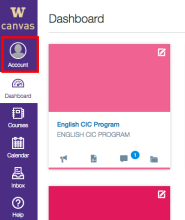
2. Select ePortfolios .
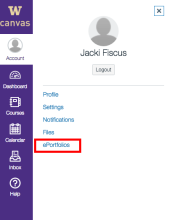
3. Click Create an ePortfolio, which is on the right side of the screen.

6. Now you are ready to create pages!
How to Create ePortfolio Pages:

- Once you have created and saved all of your pages, you are ready to start adding content!
How to Add Content to ePortfolio Pages:

- The Rich Text Content [1] function lets you enter text directly on your page and edit as you go. This is the default way to enter content. This will likely your reflective text for the portfolio.
- The HTML/Embedded Content [2] option will allow you to link to media or include media such as videos within your portfolio. You may want to use this function to enhance the appearance of your site or contribute relevant content to your work.
- The Course Submission [3] option will allow you to embed any work submitted via Canvas. This is useful for directing your instructor to drafts of your work from your current or previous quarters.
- Image/File Upload [4] will let you attach work not submitted via Canvas (for example, additional essay drafts or peer reviews).
- You may add content boxes by selecting from options in the Add Content menu. IMPORTANT TO NOTE: Each time you add content, you must add a new content box. So, if you have several files to upload, you will need to add a new content box each time. The same rule applies for all of the content types.

- After you've finished editing, you are ready to share!
How to Share the ePortfolio:
If you have not made your ePortfolio public, you will need to share your ePortfolio , especially with your instructor. Sharing a private ePortfolio link will give others access to viewing your ePortfolio without having to log into Canvas.

How to access your ePortfolio in the future:
- HOW TO ACCESS ePORTFOLIOS: Go back to the portfolio dashboard by clicking link below the Edit this page button. Right-click on the Copy this link option and submit to instructor on Canvas eportfolio assignment page. This lets the instructor make sure she/he can view all submissions. You do not have to submit again after the first time. Your instructor will see your updated content, and will not review it until the due date.
- Try to view your own submissions. You will likely get an error message. Try clicking "View original submission." Your portfolio should now display.
Sample Portfolios
Below are some examples of what the pages of a finished Canvas ePortfolio will look like:
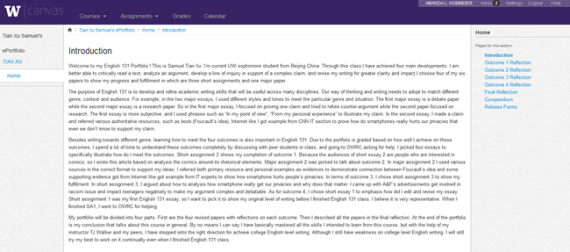
Additional Resources
- EWP Learning Outcomes
And here are some successful sample Canvas ePortfolios from former EWP 100-level Composition students:
- Newsletter
Web Request Blocked
Your request has been identified as a security risk and has been blocked by TeamDynamix. If you believe the request is valid, please report the blocked web request. You'll need to include the Blocked Request Url and Support ID in your report.
ePortfolio Assignment for Business Students
On this page, examples of student eportfolios, assignment preparation, assignment deliverables, how-to videos.
The Crowell School of Business requires all of its graduates to develop an ePortfolio website. This is a requirement to be accepted into the Crowell School of Business. Your ePortfolio is an opportunity for you to develop a website that is presentable to employers for future job and internship opportunities. You will continue to work on the ePortfolio throughout your entire time as a Business major and it will be finally assessed in your concentration Capstone course.
Before you get started, take a look at what you will be building. Here are some examples of recent ePortfolios built by students from the Crowell School of Business. You can find even more examples further down this page.

Sam Becker-Miyadai - Marketing

Stephen Joffer - Business Analytics
You can find more ePortfolio examples at the ePortfolio Showcase page.
Here are the steps to completing this assignment:
- Know what your ePortfolio is communicating.
Step number one in creating your ePortfolio is to close your computer, pull out a notebook, then STOP and THINK!! Think about the personal brand that you want your website to communicate to those that view it. In other words, what do you want the recruiter looking at your website to think about you? Do you want them to know you are a social media expert? Do you want them to know you are an aspiring marketer in the field of real estate? Having a personal brand will help give you direction as you build your website. If you don’t know how you want to brand yourself that’s okay , but these are the type of things you should be thinking about as you build your website and prepare for your professional career.
Be sure to check out this advice on how to build a personal website .
- Determine your platform.
There are many website building platforms which you can use to build your ePortfolio. Many students have chosen to work on Squarespace , Wordpress , and Wix . Each platform has its own advantages and disadvantages; some are free and some have a monthly cost. If you are unsure which platform to use, speak with your professor about which one would be best for you to use. The instructional videos that go along with this web page are currently based off using Squarespace as a platform.
- Get to know your platform.
The more you know what you are able to do on your building platform, the better your website will be. Spend at least 30 minutes just messing around with the platform and template you have chosen. How do you change the header fonts? Does the template automatically resize pictures? How do you edit the main navigation? These are the type of question you should be asking yourself as you initially work with your template.
- Determine your ePortfolio website pages
It is now time to determine which pages should appear on your ePortfolio. Your ePortfolio should contain information about who you are, your professional experience, and your academic experience. This is the section where you need figure out how to communicate that information. At a minimum, you should have four pages: a home page, a page to show off your accomplishments, a page to describe who you are in some detail, and a page for your resume. You may want to create more than one page to show off your accomplishments, breaking them down by category (such as “class projects”, “internships”, etc.). You are welcome to be creative and add other pages as well, such as a page to show off your travel experiences, hobbies, or a Contact Me page. It is up to you to decide which pages you need based off what message(s) you want to convey about yourself.
Your goal is to make your website as easily to navigate and understand as possible. This includes your main navigation bar (main menu) at the top of your website, the buttons that help your audience move around your website, and any secondary navigation bars you might have. Be sure to think through the best way to navigate the pages you develop.
- Thinking through the design
A great looking website is defined by how the content is placed on the website pages. You don’t want to just throw massive amounts of text on the website next to a huge picture. You want to lay all of your content out very simply on the webpage.
If you don’t have a great “design eye” I would recommend using design blogs, Pinterest, or Tumblr for design inspiration. Pinterest is my favorite resource to see how great designers are laying out their websites.
Here are a couple great links to resources:
- A Pinterest board
- Tumblr Web Design Tag
- Website content
For each page, be sure you think through what content you can provide. Ideally, you will want to select items that have a good mixture of images and descriptive text. If you have a video or audio file that you can include, that will add an extra dimension of richness.
When you want to highlight your experiences (both academic and extra-curricular), choose projects where you can demonstrate your accomplishments through both narrative text and an artifact, such as a file attachment or video. For example, if you did a marketing project that you would like to highlight, you will want to be able to describe it on the web page and then also include a link to the actual project. If you did a presentation that you think would be a valuable contribution to the site, include a description, a link to the slides, and (ideally) a video of the presentation. You could also add in any metrics you have on a project. For example if you had a social media internship, by what percentage did you grow the account? Do you have graphs that can show this?
- Reflection and Critical Thinking
Besides providing proof of your talents, the ePortfolio will also demonstrate to potential employers your critical thinking skills. In order to do this, you will need to provide some reflection on one or more of your assignments. This shows the person viewing your profile that you are learning from your experiences. More details on this will be given in the deliverables section.
For this assignment, you are required to complete the following list of deliverables:
- A website developed specifically for the purposes of being your Biola Crowell School of Business ePortfolio. It should have its own web address and not be a part of any other website.
- The website should use responsive design and be easily navigable on a mobile device as well as a desktop. All website development tools now have responsive design templates available for you to work with.
- The website should contain a high-quality photograph of you on the home page. The photo should be only of you and should be appropriate to the brand you are trying to project.
- The website should contain at least one academic project and one extra-curricular project with appropriate text, images, videos, and other artifacts as needed.
- For at least one of the projects selected, you should provide a critical thinking component. Begin by briefly discussing the reason you chose this project and give background/brief overview of it. You should then describe what you learned by doing it, including a discussion of the skills you specifically learned that could help your career. Then answer the question: if you could do this project again, what would I do differently? Support with specific details and examples.
- The website should link to your LinkedIn account. If you do not have a LinkedIn account, please create one as it will be a requirement for all business students.
- Log in to: biola.edu/handshake
- Click "My Profile"
- Scroll down and add your ePortfolio link as a "Project."
- Finally, and most importantly: The website should reflect the fact that you have reviewed the guidelines above and have taken them seriously. It should reflect a significant amount of effort on your part to customize it.
Please review the attached rubric for details on how this project will be graded.
Please remember that you will be expected to maintain your ePortfolio for the entire time you are a student in the Crowell School of Business.
- Teaching Resources: Commonly Asked Questions about Teaching Practices and Educational Technology

Introduction to ePortfolios

What is an ePortfolio?
An ePortfolio is a personal website that showcases skills, experiences, and knowledge to an outside audience, such as graduate schools or potential employers. ePortfolios are websites that include the following:
- Consistent Message — A common theme that connects students’ experiences, often referred to as a personal brand
- Artifacts — Evidence of relevant experiences, such as an image, document, or video
- Reflection — Written content that contextualizes the significance of the artifact and experience for a professional audience
Why are ePortfolios Useful?
ePortfolios are a valuable tool to develop skills like critical thinking and communication as well as a platform to display these skills to an external audience.
- The process of creating an ePortfolio includes gathering evidence and reflecting on curricular and co-curricular experiences.
- Drawing connections between experiences and describing their value will prepare students for networking, applications questions, and interview situations.
- Faculty can use ePortfolios for formal and informal assessment to inform curricular revisions
How to Get Started?
To get started with an ePortfolio, follow the steps below.
- Determine where the ePortfolio fits within course content and current assignments.
- Revise or create assignments that lend themselves to artifacts for an ePortfolio.
- Show students how to archive their work through a logical and accessible process. This includes using consistent file names and gathering evidence. For example, students may create a folder for each course where they save final projects and reflections, naming the files LastName.ProjectName.Date.
What if I Need Support?
The OTL is available to support you ! Reach out to [email protected] today!

2150 E. Evans Ave University of Denver Anderson Academic Commons Room 350 Denver, CO 80208
Copyright ©2019 University of Denver Office of Teaching and Learning | All rights reserved | The University of Denver is an equal opportunity affirmative action institution.
Ways to Teach ePortfolios

ePortfolio pedagogy is a great way to engage students in reflection, learning, growth, and transfer and can be used across the disciplines!
Teaching eportfolios: the beginning .
Tips and Tricks to get started:
- Start at the beginning of your semester by introducing students to the ePortfolio so they keep in mind where to store artifacts and have time to experiment with technology.
- Articulate the purpose behind ePortfolios and why they are useful to students.
- Do low-stakes assignments in the technology platform so students have a chance to practice.
- Draw on the expertise of folks around campus. You don't need to be a technology expert to teach ePortfolios! We are here to help!
- Play around and create your own ePortfolio draft to anticipate student questions and inform your own learning.
- Have students reflect at the beginning of the course on their learning, personal, and professional goals and/or whatever you are hoping they get out of the course. They can then return to these throughout the semester and illustrate in their ePortfolios growth.
Teaching ePortfolios: The Messy Middle
There are some key concepts to teaching ePortfolios in the middle. These include peer review/feedback, reflection, and self-assessment.
PEER REVIEW/FEEDBACK:
Throughout the creation of their ePortfolios students can provide feedback to each other. Peer Review is an essential way for students to practice giving constructive feedback, interpreting audience experience, understanding expectations, and seeing examples. We recommend doing at least one round of peer review for students' ePortfolios. Some guiding questions can include:
- As a viewer - how accessible is the ePortfolio?
- As a viewer - do you understand the purpose of the ePortfolio (i.e. is there a clear connection between artifacts and contextual information)?
- As a viewer - is there a clear "voice" and/or digital identity? What are some ways this is expressed throughout the ePortfolio?
- As an ePortfolio creator - what are some resources and/or strategies you've found most helpful?
These questions can also be used for instructors to provide feedback on student's ePortfolio to go beyond a checklist to more formative feedback.
REFLECTION:
Reflection is an essential aspect of a learning ePortfolio and the learning process in general. ePortfolios are an excellent way to facilitate reflection as students are contextualizing artifacts, explaining their personal, professional, and/or community goals, and highlighting their learning process. We recommend students reflect throughout a course and include these reflections in their ePortfolios. Here are some useful reflection questions for ePortfolio learning based on Gibbs' Reflective Cycle :
Description: What materials are included? What experience, class, or project are you highlighting?
Feelings: What were you feeling while creating these? Were any fun, particularly challenging, etc.?
Evaluation: What did you do well and what did you struggle with? Which of your materials illustrate your best work and your learning work?
Analysis: Why does this matter? What does this illustrate about my growth or learning?
Conclusion: Why should the audience care? What is the main takeaway?
Action Plan: What will I do in the future? How do these materials represent my goals or transfer?
SELF-ASSESSMENT
ePortfolios provide a useful space for students to self-assess their learning. Although we typically see self-assessment as something that happens at the end of a course, ePortfolios provide students a space to look at artifacts from a unit or portion of the class and reflect on their current process. By making arguments for how they are meeting the outcomes and/or objectives of a course students are able to more easily articulate what they are supposed to be getting out of the course and how it relates to their own meaning-making. Some guiding questions for self-assessment include:
- Did I work as hard as I could have?
- Did I set and maintain high standards for myself?
- Did I spend enough time to do quality work?
- Did I regulate my distractions and procrastination in order to do my work?
- Did I make good use of available resources?
- Did I ask questions if I needed help?
- Did I review my work for possible errors?
- Did I examine best practices/examples of similar work?
Teaching ePortfolios: What's Next: Transfer of Learning
As students complete their ePortfolios, there are two major steps communicating and showcasing the learning and answer the question "What's Next?" Some strategies for helping students communicate their learning include:
- Classroom Showcases - these can help students illustrate to one another their learning throughout a course. It can be especially helpful to pair up with another course also using ePortfolios to showcase learning across campus and different disciplines
- Linking it to other places - students creating career ePortfolios can combine their learning with other platforms such as LinkedIn or Handshake to help potential employers know more about what they value
- Supporting the ePortfolio Gallery - for our own ePortfolio website we encourage students to submit their ePortfolios so we can continue to grow and learn from one another.
"What's Next?" Transfer of Learning
ePortfolios should not stop at the end of a course, program, curriculum, etc. Although students might not use the same ePortfolio, it is useful to think about transferrable skills as students move forward. Some guiding questions for students include:
- What aspects of learning can I transfer from this ePortfolio to another (for example from learning to career)?
- What can I teach my peers about ePortfolios now that I've completed one?
- What has creating an ePortfolio allowed me to do (i.e. biography, identify goals, experiment with multimodal writing, etc.)
Having students keep these questions in mind can help them as they move from one ePortfolio to another.

Resource: ePortfolio Assignment Sheets
Example Strategies (Michigan)
ePortfolio Biography (Illinois)

Resource: ePortfolio Lesson Plans
Guidelines for In-Class Peer Review
Brainstorming ePortfolio Artifacts (PDF Auburn)
ePortfolio Quiz and Analysis (PDF Auburn)
UA Inclusive ePortfolios

Resource: Reflection Lesson Plans
UA's Teacher's Guide to Reflection
Reflection Activities
Self-Assessment (Cornell)
Ohio State nav bar
The Ohio State University
- BuckeyeLink
- Find People
- Search Ohio State
ePortfolios in the Curriculum: Incorporating Reflection into Your Course

If a student’s degree program was a constellation, each curricular, co-curricular, and extracurricular experience would be a star in that constellation. To make meaning from these varied experiences, students need opportunities for reflection so they can “connect the dots” in what might otherwise be a fragmented curricular experience. Reflection is central to ePortfolio pedagogy, and ePortfolios are powerful tools for helping students connect the dots and integrate their learning.
An ePortfolio is an online space where students can create, collect, curate, and connect their academic experiences and engage in reflective writing—a metacognitive process that supports students’ ability to turn their experiences into learning. ePortfolios can make learning visible, advance student success, and provide an opportunity for students to synthesize their learning across disciplines. They have the potential to bridge curricular fragmentation by holistically connecting students’ classes, skills, and experiential knowledge with a digital representation of their thinking (Conefrey & Smyth, 2020).
This introduction to ePortfolios will help you begin to incorporate ePortfolio pedagogy and the practice of reflective writing in your courses.
ePortfolios in Higher Education
In 2016, the American Association of Colleges and Universities (AAC&U) identified ePortfolios as the eleventh high-impact practice (HIP) . HIPs are educational practices that foster student engagement, support key student outcomes, and facilitate deeper learning.
The ePortfolio is an intentionally designed instructional approach. By helping college students connect and make sense of their varied experiences inside and outside of the classroom, ePortfolios prompt regular reflection and lead to deeper learning (Yancey, 2019). They represent both a process —promoting deep learning as students reflect on the integration of their courses, assignments, and co-curricular experiences—and a product —serving as a digital space for students to showcase key assignments, achievements, and other artifacts of their learning. Given this, ePortfolios are a meaningful vehicle for both formative and summative assessment .
High-Impact Practices (HIPs)
Learn about high-impact practices and course types in High-Impact Practices: Enhancing the Student Experience or explore Integrative Practices within the GE , including service-learning, education abroad and away, research and creative inquiry, interdisciplinary team-taught courses, and instruction in a language other than English.

At Ohio State, the General Education curriculum has a structured pathway for students to incorporate reflective learning in ePortfolios throughout the undergraduate experience. The Bookends courses—Launch Seminar and Reflection Seminar—are designed to help students contextualize and capitalize on their learning throughout the course of the GE curriculum. Each Bookend includes an ePortfolio component, introduced in Launch and culminating in Reflection. In between the Bookends, students keep up their reflective practice and add learning artifacts to their ePortfolios. Learn more in Planning Your Course for the General Education Curriculum.
Ohio State’s ePortfolio service is powered by PebblePad. With PebblePad, learners can create multiple portfolios, pages, activity logs, and other items. Instructors or program leaders can create and share resources, such as workbooks and templates, to guide students through a learning experience. See what a PebblePad ePortfolio can look like by exploring exemplars from the PebblePad Community. Learn how to use PebblePad.
If you're leveraging ePortfolios in your course, a number of other available tools can support your students to develop digital repositories of their work. Options include U.OSU (Ohio State's web authoring tool), OneNote or OneDrive, and Adobe Express. Depending on your goals, you might choose a tool based on factors such as students' familiarity with the technology as well as how user-friendly, flexible, robust, and aesthetically appealing each platform is. Explore a variety of approved tools on our Additional Tools page.
Benefits of ePortfolio Pedagogy
If you’re thinking about using ePortfolios in your course, you might be wondering how they can benefit your students. Consider that ePortfolios:
- Deepen learning as students engage in reflective practice and metacognitive thinking about their educational experiences and portfolio artifacts.
- Support students to practice skills that will benefit them in their professional lives and to make connections between their learning and personal goals.
- Promote equitable teaching practices, foster ownership of learning, and align with Universal Design for Learning principles.
Deeper Learning Through Reflection and Metacognition
Reflection is at the core of ePortfolio learning (Yancey, 2009). Reflection includes providing intentional opportunities for students to think about their goals and behaviors and integrate their learning, often through reflective writing. According to the National Association of Colleges and Employers (NACE), it is essential for students to have opportunities to enhance the communication and critical thinking skills that help them translate their course work, experiential learning, and life experiences into written artifacts (2022).
Reflective practice has been shown to promote students’ metacognition (thinking about one’s thinking) by making them more aware of how they learn. In ePortfolio work, students engage in metacognitive work as they build an understanding of how their learning came about and how it has changed over time (Bokser et al., 2016). They can synthesize and integrate their learning across courses and experiences to find meaning (Batson, 2011; Peet et al., 2011), which is not always inherent in undergraduate degree programs. Through these reflection opportunities, and in the process of creating ePortfolios, students develop higher-order thinking skills and engage in deeper learning (Burns et al., 2000; Chittum, 2018).
“It is clear that reflection is at the center of eportfolio pedagogy. Reflection allows students to build bridges between prior and current learning, across semesters and among courses and disciplines. It allows for the construction and understanding of knowledge within personalized contexts to make the curriculum come alive with meaning for each student.” (Buyarski et al., 2017, p. 9)
Through ePortfolios, educators provide students with a structured means to make meaning from what they are learning, to reflect upon how and why the learning has occurred, and to see the relevance of their educational experiences across varied personal contexts.
Supporting metacognition
Metacognition involves active thinking about one’s thinking and learning, including the ability to self-monitor, self-regulate, and self-control. Self-monitoring refers to our awareness of learning as it occurs. For example, you might ask students to assess their understanding, reflect on the learning strategies they used, or evaluate their performance on assignments. Self-regulation and self-control are related processes that involve turning this awareness into action—in other words, checking in on our approach to learning and adjusting it as needed. For example, a student might realize they need to reread a passage, try a new study strategy, or seek help from you or a classmate. Self-monitoring, self-regulation, and self-control are skills that can be taught.
As an educator, there are a variety of ways you can facilitate and support students' learning processes. Check out the strategies to stimulate reflection below and read more in Supporting Student Learning and Metacognition .
Skill-Building and Career Readiness
While ePortfolios may be made up of artifacts and reflections from students’ academic studies, they also help them build skills that relate to future career goals. Through ePortfolio work, students can develop digital literacy and other 21 st century communication skills (Gallagher & Poklop, 2014; Kahn, 2019) that will benefit them in their post-graduate lives. ePortfolios are well-suited to sharing complex experiences, career competencies, and materials that other formats may not allow, such as resumes, cover letters, and transcripts (Hickey et al., 2019).
The ePortfolio medium provides a uniquely recursive space for students to engage with their own goals and development by returning to prior artifacts and reflections to curate or modify them as they make meaning of their learning (Buyarski et al., 2015). The connections made can extend to professional interests and other personal endeavors. As an evolving virtual space where learners can create a digital identity, explore their personal brand, and engage in digital storytelling, ePortfolios empower students to practice useful skills that may not otherwise be found in their coursework (Jones & Leverenz, 2017; Yancey, 2013).
Equitable Practices in Teaching and Learning
Research has demonstrated that high-impact practices (HIPs) are an evidence-based approach to closing equity gaps and may be especially beneficial for students from underserved backgrounds (Brownell & Swaner, 2010; Finley & McNair, 2013; Kuh, 2008). Studies suggest that when coupled together, HIPs can increase engagement and persistence, especially for students from historically marginalized groups (Conefrey, 2017; Kilgo et al., 2015; Ribera et al., 2017). Unlike some HIPs that require a large time investment (e.g., internships, undergraduate research via independent study) or present financial barriers to participation (e.g., global learning through study abroad), ePortfolios are accessible to all students when they are effectively integrated into a course or curriculum.
Students choose which work best represents themselves and their learning in their ePortfolios. This process of reflection and curation promotes ownership of learning , which can increase students' sense of agency and relevance in their lives and courses (CAST, 2018; Chittum, 2018). Ownership of learning is an important aspect of Universal Design for Learning (UDL) , a framework for understanding how people learn that helps educators promote optimal learning opportunities for all students. Other UDL principles that are easily implemented with ePortfolios include providing options for learners to use multiple tools for knowledge construction and composition and multiple modalities to demonstrate their learning.
ePortfolios can support student learning in courses across the disciplines. Since they are curated over time, those who progress through their degree programs at varied rates or take breaks have an enduring product of their learning that they can pick back up when they’re ready (Oswal, 2013). Thus, ePortfolios are a dynamic and sustainable practice for student reflection and active engagement (Rhodes, 2018) that fit well not only into your course and the undergraduate curriculum, but also into your students’ busy lives.
Read more about ownership of learning and Universal Design for Learning .
ePortfolio Course Integration

When integrating ePortfolios in your course, start with how they will align with your specific learning outcomes . You might use them to support existing course activities by providing a dedicated space for students to showcase work, reflect on assignments and learning, and share their knowledge with others. The activities and assignments in your course for which students already produce are likely meaningful artifacts for them to include in ePortfolios.
Assignments that lend themselves well to ePortfolio integration include signature assignments . These are substantial learning assessments that are connected to programmatic or general education learning goals. Signature assignments typically:
- Ask students to convey their understanding of core course content
- Support students to synthesize and apply their learning
- Offer students agency and choice in the application of their learning
- Include a “real world” application
- Provide a space for reflection and connection (Roach & Alvey, 2021)
Examples of signature assignments to incorporate in ePortfolios are presentations, essays, case studies, service-learning projects, group or team-based learning activities, multimedia content creation , and more.
Strategies to Stimulate Reflection
Remember that reflection is key to ePortfolio pedagogy—beyond deciding which course activities align well to ePortfolios, you must plan how you will support students’ reflection and metacognition. Students may achieve deeper levels of reflection with intentionally scaffolded prompts. Providing options and a variety of ways to reflect can also yield more engaged reflection.
Below are a few creative ways to stimulate your students’ metacognitive processes for integrative learning and reflection.
“Wrappers” are low-stakes ways for students to think about how they learn and to critically reflect on their performance and the steps they took to prepare for an exam or assignment. You can distribute a wrapper when handing back an exam and prompt students to consider your feedback as well as their own performance on the exam. Carnegie Mellon University shares examples of different exam wrappers .
There are few instances when students are afforded the chance to integrate their learning across semesters and disciplines. Offer opportunities for students to connect their prior knowledge (what they already know) with what they have learned in your course. An example question might be: “What did you learn that connects with what you are learning or have learned in other courses?”
At the end of the semester, ask students to write a letter or discussion post to future students who will take your course. Encourage them to describe what learning and study strategies will be useful and why, what concepts or skills their peers will learn, and any advice they wish they had when taking the course.
At the beginning of the semester, ask students to describe ideas, experiences, and/or understandings they have about your course’s subject matter. At the end of the semester, ask them to return to what they wrote, determine if there are any misconceptions they’d like to correct, and explain why their thinking has changed.
Concept maps are graphic organizers that visually represent connections and themes related to a stated concept. Have students depict relationships, similarities and differences, or processes using concept maps. Students can then reflect upon and explain their reasoning for how they laid out their concept maps. There are many online tools your students can use to create dynamic concept maps.
Assessment and Grading
As noted above, ePortfolios offer a unique way to include both formative assessment and summative assessment in one platform. As always, it's best practice to first determine the learning outcomes associated with your ePortfolio project and which types of evidence (assignments, assets, and so on) will support those outcomes. Share the criteria by which all portfolio work will be assessed with your students and make this available early on in the semester. Using a clear and well-designed rubric will not simply make your grading process more fair and efficient, but will also make your expectations transparent so that students are better prepared for success. You can also have students use your rubrics to self-assess their own work as an added reflection activity.
The American Association of Colleges and Universities (AAC&U) has designed several VALUE rubrics that can be applied to ePortfolio work, depending on your goals for your students.
Rubrics in CarmenCanvas
Explore best practices for creating a meaningful rubric and adding rubrics to Carmen by registering for a session of the Creating Rubrics in CarmenCanvas workshop or viewing a previous session recording .
Learn more about Designing Assessments of Student Learning.
- ePortfolio at Ohio State (website)
- International Journal of ePortfolio (open access journal)
- PEARL Publications on ePortfolio (research archive)
- High-Impact Practices, AAC&U (website)
Learning Opportunities
Brownell, J. E., & Swaner, L. E. (2010). Five high-impact practices: Research on learning outcomes, completion, and quality . Association of American Colleges & Universities.
Buyarski, C., Oaks, S., Reynolds, C., & Rhodes, T.L. (2017). The promise of ePortfolios for student learning and agency. In T. Batson, K. S. Coleman, H. L. Chen, C. E. Watson, T/. L. Rhodes, & A. Harver (Eds.), Field guide to ePortfolio (pp . 6-12). Association of American Colleges and Universities.
Conefrey, T. (2017). LEADing the way with ePortfolios in a first-generation learning community. International Journal of ePortfolio , 7 (2), 161-173.
Conefrey, T., & Smyth, D. (2020). Reflecting, Integrating, and Communicating Knowledge through ePortfolios to Increase Civic and Scientific Literacy. International Journal of ePortfolio , 10 (1), 1-18.
Finley, A., & McNair, T. (2013). Assessing underserved students’ engagement in high-impact practices [Report]. Association of American Colleges & Universities. http://files.eric.ed.gov/fulltext/ED582014.pdf
Hickey, D. T., Coleman, K. S., & Chen, H. L. (2019). New ways to demonstrate achievements: warranting ePortfolio evidence. In In T. Batson, K. S. Coleman, H. L. Chen, C. E. Watson, T. L. Rhodes, & A. Harver (Eds.), Field guide to ePortfolio (pp . 50-58). Association of American Colleges and Universities.
Kahn, S. (2019). Identity development as curriculum: A metacognitive approach. In K. Yancey (Ed.), ePortfolio as curriculum (pp. 89-105). Stylus Publishing, LLC.
Kilgo, C. A., Sheets, J. K. E., & Pascarella, E. T. (2015). The link between high-impact practices and student learning: Some longitudinal evidence. Higher Education, 69( 4), 509-525.
Kuh, G. D. (2008). High-impact educational practices: What they are, who has access to them, and why they matter . Association of American Colleges & Universities.
National Association of Colleges and Employers. (2022). Job Outlook 2022 Spring Update . Author.
Rhodes, T. L. (2018). Lift every voice: ePortfolios for creating and integrating. International Journal of ePortfolio , 8 (2), 87-89.
Ribera, A. K., Miller, A. L., & Dumford, A. D. (2017). Sense of peer belonging and institutional acceptance in the first year: The role of high-impact practices. Journal of College Student Development , 58 (4), 545-563.
Yancey, K. B. (2019). ePortfolio as curriculum . Sterling, VA: Stylus Publishing, LLC.
Related Teaching Topics
Designing assessments of student learning, high-impact practices: enhancing the student experience, planning your course for the general education curriculum, related toolsets, search for resources.

You're signed out
Sign in to ask questions, follow content, and engage with the Community
- Video Guide
ePortfolios Overview (Students)
- Subscribe to RSS Feed
- Printer Friendly Page
- Report Inappropriate Content
- eportfolios
in Video Guide
Community Help
View our top guides and resources:.
To participate in the Instructure Community, you need to sign up or log in:
Our websites may use cookies to personalize and enhance your experience. By continuing without changing your cookie settings, you agree to this collection. For more information, please see our University Websites Privacy Notice .
Center for Excellence in Teaching and Learning
Educational Technologies
- Design Tips
- Reflections
- Reflection Models
- Sample Reflection Questions
Assessing ePortfolios
- Why Use an ePortfolio?
ePortfolios can:
- Provide assessment of learning outcomes;
- Provide evidence of performance over time;
- Demonstrate progress towards achievement of learning objectives;
- Serve as summative or formative assessment;
- Measure personal attributes;
- Enhance interaction between students and faculty;
- Stimulate reflective learning strategies; and
- Expand understanding of professional competence.
Planning to assess an ePortfolio:
- Start by identifying the learning objectives for the assignment or ePortfolio
- Determine what types of entries would best match those learning objectives
- Set the criteria for evaluating the assignment, such as rubric, rating scale, or checklist
- Explain the criteria for evaluation to the students to ensure they understand how the assignment or ePortfolio will be assessed
- Review the submitted assignment or ePortfolio
- Provide feedback to the student
How to evaluate an ePortfolio:
When evaluating an ePortfolio, multiple approaches can be taken. The first is to evaluate achievement of the defined learning objectives. The second is to evaluate the reflectiveness of the ePortfolio. The last is to evaluate the ePortfolio as a whole. These can be done with rubrics, checklists, or other documentation, but qualitative evaluation of learning should also be considered. To document achievement of learning objectives, faculty can develop or find a rubric pertaining to the learning objectives. Another option is to use the AACU VALUE rubrics.
AACU VALUE rubrics
The Association of American Colleges and Universities (AACU) developed the sixteen Valid Assessment of Learning in Undergraduate Education (VALUE) rubrics as part of its Liberal Education and America’s Promise (LEAP) initiative. VALUE rubrics can be utilized in diverse learning pathways and fields of study to assess if students have made progress towards or achieves the learning objectives defined by faculty or the institution or have achieved learning outcomes considered essential by employers. Since 2009, VALUE rubrics have been utilized for assessment across the United States and internationally. They have been approved for use in all regional and some professional self-study reports for accreditation. The VALUE rubrics cover sixteen integrative topics across three domains.
The rubrics are available for download at: https://www.aacu.org/value-rubrics
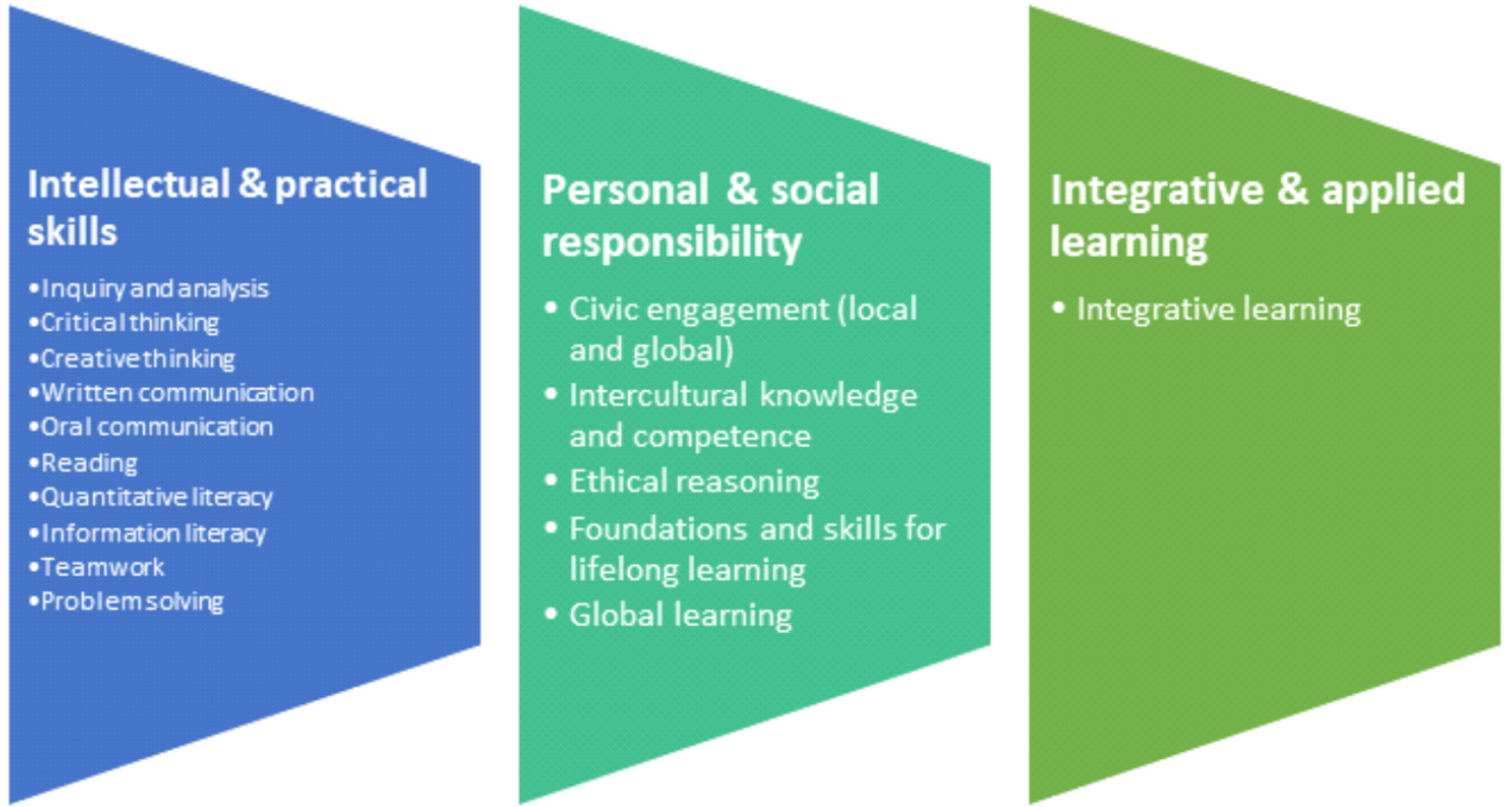
If evaluating the reflectiveness of a portfolio, the faculty might consider a rubric containing criteria related to clarity, relevance, analysis, interconnections, and self-criticism. If holistically evaluating an ePortfolio, the faculty might consider a rubric containing criteria related to selection of artifacts, reflection/critique, use of multimedia, citations, navigation, layout and readability.
How an ePortfolio can contribute to assessment
An ePortfolio can be utilized for the assessment of learning and for the assessment for learning. In the assessment of learning, faculty are measuring each student’s achievement of learning objectives. With this approach, faculty are intentionally defining the assessment activities and conducting an end-of-unit assessment of the achievement of the learning objectives associated with this assessment. The assessment for learning makes visible to the student and the faculty the progress students are making towards achievement of learning objectives, but also enhances lifelong learning skills, attitudes, and strategies as students develop their own approaches to advancing their abilities. Assessment for learning provides formative feedback to the student on which they can grow. Such an approach gives students more freedom in what to submit in the portfolio but does require intrinsic motivation for students to keep up with the process. Assessment of learning versus assessment for learning
| Purpose prescribed | Purpose negotiated |
| Artifacts mandated and scored for external use | Artifacts chosen by learner and feedback provided back to learner |
| Organized by the instructor | Organized by the learner |
| Summative (past to present) | Formative (present to future) |
| Institution-centered | Student-centered |
| Requires extrinsic motivation | Intrinsically motivating |
| Positivist | Constructivist |
Source: Documenting learning with eportfolios: a guide for college instructors by T.P. Light, H.L. Chen, and J.C. Ittelson, 2012, Josey-Bass. Most faculty and students are more experienced with assessment of learning. To create more comfort with assessment for learning, faculty may incorporate activities to expand student understanding of the goals they are attempting to achieve.
- Ask students to answer prompts about their own understanding or interpretation of each learning objective;
- Have students define what work samples would demonstrate achievement of these learning objectives and add them to their ePortfolio when they are developed; and
- Have students write reflection statements of useful insights, highlights, decisions, or next steps.
Always use the online HTML Editor to compose the content for your website easily.

IMAGES
COMMENTS
Step 2: Collect, Select, Reflect. All ePortfolios include artifacts, contextual information, and digital identity choices. Let's break this down further: Artifacts: These are the "evidence" for your ePortfolio and the work you want your audience to engage with to help understand your ideas, skills, etc. Examples include resumes, drafts ...
One assignment that involved many of the ePortfolio features was the ePortfolio "Brand" assignment, in which students had to create their own personal brand and market themselves on ePortfolio. Digital Storytelling Assignment: Research an industry issue and create a marketing strategy that
Click the "Load e-Portfolio" button and the assignment page in your ePortfolio will appear (outside of Canvas). Always access & submit your ePortfolio assignments through assignment links in Canvas. Do not access the ePortfolio by manually navigating outside of assignments in your course. Otherwise, your grade will not be returned to Canvas.
Each separate assignment of sub-unit of work can be presented upon a single ePortfolio page, with the teacher scrolling up or down as required to view the entire submission. ... Exploring student experiences of e-portfolio implementation as a vehicle of reflective learning at Stellenbosch University, The Independent Journal of Teaching and ...
You'll face 11 essential decisions in your pursuit of portfolio excellence. 1. Know Your Purpose. According to Dr. Helen Barrett (PDF), portfolios fall into two categories: the positivist approach (using portfolios for learning), and the constructivist approach (using portfolios as learning).
A good ePortfolio is both a product (a digital collection of artifacts) and a process (of reflecting on those artifacts and what they represent). Like a Learning Management System (LMS), ePortfolios exist online and support student learning. They differ from LMS in two key ways: ownership and control. In a university course, the LMS is "owned ...
An ePortfolio is a collection of work (evidence) in an electronic format that showcases learning over time. Creating a digital portfolio encourages students to take responsibility for their learning and showcase that learning with others. An ePortfolio lets students organize, document, and display their most significant learning experiences in ...
Build your own ePortfolio. The best way to teach is to use your own experiences as an example. Building your own ePortfolio will prove to the students the benefits of doing it. You will also better understand the process, challenges, and advantages, which helps you lay out the instruction and assessment for the ePortfolio assignment.
Your instructor portfolio assignment will help you to know the expectations for your specific assignment. For more information on the Portfolio tool generally, see the Canvas Portfolio Guide. Before you Create Your E-Portfolio: Begin by logging into Canvas and opening your ePortfolio assignment. This will be your guide for understanding your ...
ePortfolio Assignment: Students choose a bacterial phylum and build an ePortfolio page over eight weeks. Page components include: Introduction: Written for high school-college-age students, includes important genera, close relatives, ecology, energy-carbon source and typical mode of nutrition, relevance to humans and the Earth, role in nutrient ...
An ePortfolio is your personal website that allows you to document, deepen, and reflect on your learning experiences during your time at LaGuardia. Additionally, you can download and share this handout, either digitally or in hard copy, when introducing ePortfolio to students. Click on your preferred language: Arabic, Bengali, Chinese, English ...
Assignment Preparation. Here are the steps to completing this assignment: Know what your ePortfolio is communicating. Step number one in creating your ePortfolio is to close your computer, pull out a notebook, then STOP and THINK!! Think about the personal brand that you want your website to communicate to those that view it.
First ePortfolio assignment for LIT 132—second week: I. If possible, have a photo of yourself accessible (via email, travel drive, web) that you can upload to your ePortfolio. You will work on your Introduction page, and Academic Materials page: Introduction page-- list your goals and skills in the text boxes and upload any quotes that
Building your own ePortfolio will prove to the students the benefits of doing it. You will also better understand the process, challenges, and advantages, which helps you lay out the instruction and assessment for the ePortfolio assignment. Tie ePortfolios to assessment. Building an ePortfolio can be very time-consuming.
To get started with an ePortfolio, follow the steps below. Determine where the ePortfolio fits within course content and current assignments. Revise or create assignments that lend themselves to artifacts for an ePortfolio. Show students how to archive their work through a logical and accessible process. This includes using consistent file ...
Tips and Tricks to get started: Start at the beginning of your semester by introducing students to the ePortfolio so they keep in mind where to store artifacts and have time to experiment with technology. Articulate the purpose behind ePortfolios and why they are useful to students. Do low-stakes assignments in the technology platform so ...
E-portfolios are a purposeful selection of artifacts together with reflections that represent some aspect of the owner's learning. (Lorenzo & Ittelson, 2005) They create online spaces for faculty and students to communicate, share, reflect and collaborate in and outside of the classroom. Darren Cambridge author of Eportfolios for Lifelong ...
Sample ePortfolio Reflective Assessment Assignment. Practice & Pedagogy of ePortfolios. Implementing portfolios come with some difficulties. Below are some resources t o facilitate an effective execution; The National Council of Teachers of English shares these principles and practices. This resource also has provides links to "well-conceived e ...
The activities and assignments in your course for which students already produce are likely meaningful artifacts for them to include in ePortfolios. Assignments that lend themselves well to ePortfolio integration include signature assignments. These are substantial learning assessments that are connected to programmatic or general education ...
View Getting Started Wizard. The Getting Started Wizard will pop up to show you the basics of your ePortfolio. You can read about the Introduction, Portfolio Sections, Section Pages, Adding Submissions, ePortfolio Settings, and Let's Do It. To close the Getting Started Wizard, click the close icon.
You can quickly add a recent assignment submission to your portfolio by clicking on the name of the assignment. Select the section in which to add the submission as a page. Then add a page title. When done, click the Add Page button. To change the settings for your ePortfolio, click the ePortfolio Settings link.
Planning to assess an ePortfolio: Start by identifying the learning objectives for the assignment or ePortfolio. Determine what types of entries would best match those learning objectives. Set the criteria for evaluating the assignment, such as rubric, rating scale, or checklist. Explain the criteria for evaluation to the students to ensure ...
Introduction to Course • 2 minutes • Preview module. Creating an Effective Headline • 8 minutes. Writing Your Summary of Capabilities • 7 minutes. 7 readings • Total 90 minutes. Consent Form • 10 minutes. Choosing a Website Builder for Your ePortfolio • 20 minutes. Lesson Review & List of Action Verbs • 10 minutes.